Controls, Expressions, and Discovery Potential of Gold Mineralization in the Central-Eastern Yilgarn Craton, Western Australia: New Insights from an Integrated Targeting Study
Abstract
1. Introduction
2. Geology
2.1. Eastern Goldfields Superterrane (EGST), Yilgarn Craton
2.1.1. Overview
2.1.2. Geology and Structure
2.1.3. Deformation History
- D1 (~2720–2670 Ma): ENE-WSW-directed extension marked by rifting and greenstone deposition.
- D2 (~2670–2665 Ma): ENE-WSW-directed shortening associated with cessation of volcanism, development of NNW-SSE-trending upright folds, and N-S-to NE-SW-striking dextral strike–slip and reverse faults.
- D3 (~2665–2655 Ma): NE-SW-directed extension and extensional doming involving deep crustal exhumation and formation of late basins that record the first deposition of granite detritus in the EGST.
- D4a (~2655–2650 Ma): ENE-WSW-directed shortening resulting in tightening of earlier folds, WSW-directed thrusting along NNW-SSW-striking faults, and generation of NNW-SSE-trending upright folds and reverse faults.
- D4b (~2655–2650 Ma): WNW-ESE-directed shortening characterized by reactivation and sinistral transpression along earlier NNW-SSE-striking faults and generation of ENE-WSW-striking thrust faults recording NW and SE transport.
- D5 (~2650–2635 Ma): NE-SW-directed shortening marked by dextral strike–slip movement along N-S- to NNE-SSW-striking faults and thrusting along NNW-SSE- to NW-SE-striking faults.
- D6 (<2630 Ma): Low-strain vertical shortening and horizontal extension marked by crenulation development.
2.1.4. Metamorphic History
- Ma (>2750 Ma): Early, low-P/high-T upper-amphibolite to granulite facies assemblages are rare, restricted to magmatic arc-related ~2730 to 2810 Ma greenstone sequences in the western Burtville Terrane, and to HFSE granites and ~2675 to 2715 Ma greenstones of similar affinity in the Gindalbie Domain of the Kurnalpi Terrane.
- M1 (~2750–2700 Ma): This event produced high-P/moderate-T assemblages preserved in narrow, upper amphibolite-grade zones along major, crustal-scale faults. The structural context, burial depth, and rapid exhumation suggest partial subduction and burial of buoyant magmatic arcs during arc accretion in subduction-like environments.
- M2 (~2680–2670 Ma): A low-P/moderate-T event associated with contact metamorphism linked to emplacement of voluminous high-Ca granite melts into the upper crust, generated by partial melting of a subducted slab beneath the Kalgoorlie and Kurnalpi terranes. The M2 event coincided with cessation of volcanism and D2 crustal shortening.
- M3 (~2665–2650 Ma): This event likely reflects lithospheric extension following subduction cessation with slab rollback and sag of the previously subducted plate causing extension of the overriding plate. The M3 event coincided with D3 metamorphic core complex formation.
- M4 (~2650–2610 Ma): Low-P/high-T metamorphism was likely triggered by lower-crustal delamination, resulting in mantle upwelling and a thermal anomaly in the upper crust associated with widespread low-Ca granite magmatism.
2.1.5. Geodynamic Implications
2.2. Kalgoorlie–Kurnalpi Rift
2.3. Kalgoorlie Terrane
2.4. Kurnalpi Terrane
3. Gold Mineralization
3.1. Gold Endowment
3.2. Gold Deposit Styles
3.3. Gold Depositional Events
- D3 (~2665–2655 Ma): Development of the EGST crustal architecture during NE-SW-directed extension and metamorphic core complex formation. Major crustal-penetrating fault systems were established at this stage, linking the upper crust to a metasomatized mantle, as evidenced by the first emplacement of mafic and syenitic granites. This mantle connection likely introduced significant heat at the crustal–mantle boundary, promoting mantle-to-crust metal transfer. An important D3 deposit in the study area is Gwalia (>8.2 Moz Au).
- D4 (~2655–2650 Ma): The extensional crustal framework formed during D3 was inverted during D4, a brittle–ductile deformation event comprising an initial phase of ENE-WSW-directed shortening (D4a) followed by WNW-ESE-directed shortening (D4b). This phase coincided with a shift from high- to low-Ca granite magmatism driven by crustal melting and represents the most significant gold mineralization event in the EGST. Strike–slip deformation and reactivation of pre-existing structural heterogeneities during D4b served as highly effective fluid-focusing mechanisms. The most prominent D4 deposit is the Golden Mile (>65 Moz Au), located ~35 km south of the study area.
- D5 (~2650–2635 Ma): A subsequent stress field reorientation induced NE-SW-directed shortening accompanied by dextral strike–slip, thrusting, and low-Ca granite emplacement. Gold mineralization was primarily controlled by brittle structures. A key D5 deposit is Sunrise Dam (>10.3 Moz Au), located ~20 km east of the study area.
4. Materials and Methods
4.1. Study Background
4.2. Methodology
4.3. Geoscience and Exploration Data
4.4. Processing and Interpretation of Geophysical and Remote Sensing Data
4.4.1. Geophysical Data and Processing
4.4.2. Remote Sensing Data and Processing
4.4.3. Lithostructural (Solid Geology) Map
4.5. Mineral Systems Concept
4.6. Fry Analysis
4.7. Background to Mineral Potential Modeling (MPM)
5. Data Integration and Examination
5.1. Insights from the Enhancement Filtering of Geophysical and Remote Sensing Data
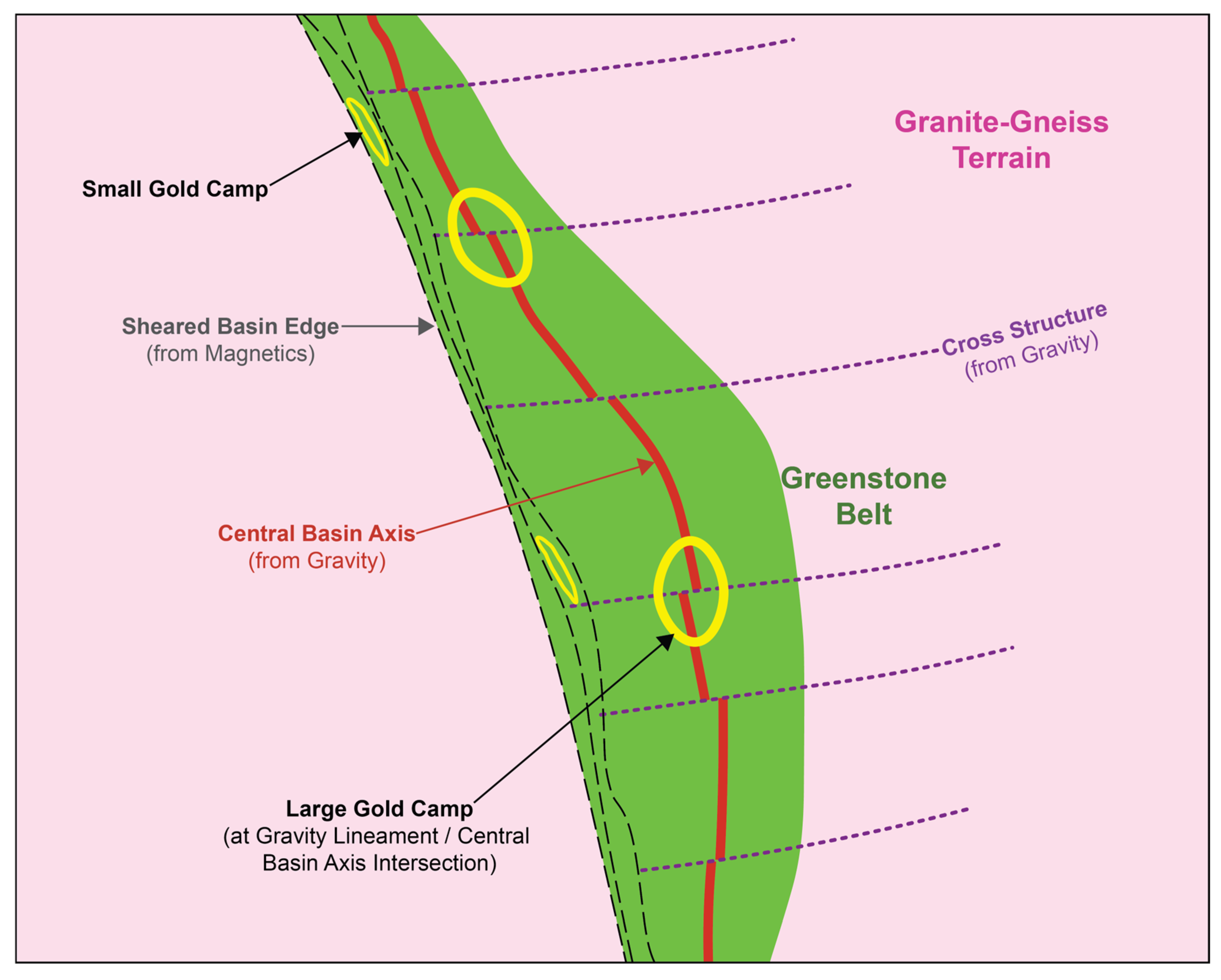


5.2. Lithostructural (Solid Geology) Interpretation
6. Targeting Model
7. Mineral Potential Modeling (MPM)
7.1. Statistical Evaluation of Predictor Maps
7.2. Continuously Weighted Mineral Potential Models
7.2.1. Continuous Fuzzy Gamma Model
7.2.2. Geometric Average Technique
7.2.3. Improved Index Overlay Model
7.3. Best–Worst Simple Additive Weighting (BWM–SAW) Mineral Potential Model
7.4. Random Forest (RF) Mineral Potential Model
8. Discussion
8.1. Geological and Structural Implications
8.2. Geophysical and Remote Sensing Implications
8.3. Mineral Potential Modeling (MPM) Implications
8.3.1. Predictor Map Performance
8.3.2. Multi-Technique Approach
8.3.3. Predictor Map Sensitivity
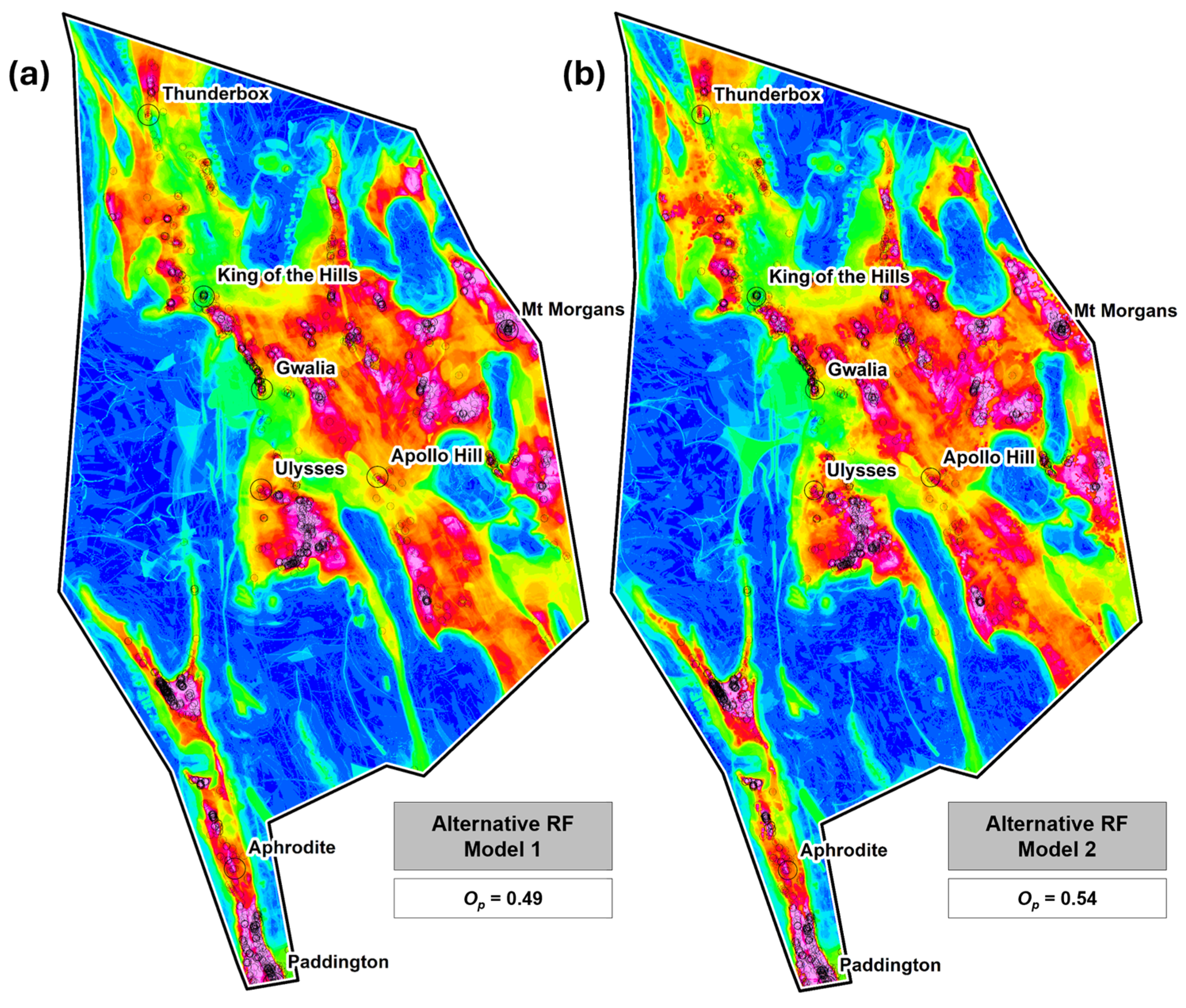
8.3.4. Using Fractal Thresholding for Target Generation
8.4. Targeting Implications
8.4.1. Role of MPM as a Targeting Tool
8.4.2. Assessment of MPM Target Areas
- Target #1: This target covers a cluster of poorly tested intrusions of the McAuliffe Well Syenite, which intruded mafic volcanic-dominated greenstone sequences, abut the first-order Keith–Kilkenny fault system, and are crosscut by E-W- to NW-SW-striking dolerite dykes. Shallow rotary air blast (RAB) drilling by Saracen Gold Mines Proprietary Limited (maximum hole depth of 45 m) returned intercepts of up to 1.00 m @ 12.28 g/t Au from 9.00 m (hole YER143), 1.00 m @ 6.94 g/t Au from 10.00 m (hole YER158), and 2.00 m @ 2.20 g/t Au from 9.00 m (hole YER159), defining surficial, saprolite-hosted gold mineralization over an area of ~400 × 300 m at the Dingo prospect. The nearby Bull Terrier prospect returned intercepts of 16.00 m @ 2.59 g/t Au from 105.00 m (hole YBD-2) and 16.00 m @ 1.52 g/t Au from 60.00 m, including 1.00 m @ 211.70 g/t Au from 65.00 m (hole YRC-63) [164,165]. No deeper or more systematic exploration drilling appears to have been undertaken across the McAuliffe Well Syenite intrusive cluster. Moreover, the area is held by several exploration companies, and this fragmented ownership, apparently persisting for decades, has likely hindered a more integrated exploration approach.
- Target #2: This target comprises prospective mafic and felsic volcanic-dominated greenstone sequences, containing chemically reactive banded iron formations (BIFs) and syenite intrusions, located along strike from the Mt Morgans gold production center. Previous drilling returned intersections of up to 6.70 m @ 13.15 g/t Au from 95.00 m (hole MRC036), 5.90 m @ 7.24 g/t from 79.00 m (hole MRC003), and 2.90 m @ 5.41 g/t Au from 112.00 m (hole MRC028), defining a modest resource of >150 koz Au @ 1.40 g/t Au at the Korong-Waihi prospect. The mineralization remains open along strike and at depth, with no drilling below a vertical depth of 150 m [166,167]. As with target #1, fragmented ownership currently hinders a more integrated exploration approach.
8.5. Post-Study Target Validation
9. Summary and Conclusions
- Structural controls: Cross-cutting N-S, NE-SW, and NW-SE fault and fracture corridors overprint the greenstone belt-parallel fabric and consequently aligned with clusters of gold occurrences. Supported by Fry analysis, these oblique structures likely represent key fluid-focusing zones that controlled mineralization.
- Geophysical insights: Gravity and magnetic data reveal concealed structural controls. Belt-parallel gravity ridges correspond to thickened mafic–ultramafic roots of inverted greenstone basins, the most prospective settings for multi-million-ounce systems. Gravity edges and magnetic edges delineate fault zones and granite–greenstone contacts. Major deposits such as Thunderbox, King of the Hills, Gwalia, Ulysses, and Paddington occur along these edges, indicating previously unrecognized cryptic crustal boundaries.
- Integrated geological framework: Enhanced gravity, magnetic, radiometric, and remote sensing filters clarified subtle but continuous fault zones, alteration halos, and greenstone basin keels not visible in published maps. These datasets were synthetized into a new, geophysically constrained lithostructural framework for mineral targeting.
- Mineral potential modeling (MPM): Five complementary techniques were applied, with the random forest (RF) model performing best and detecting ~84% of known deposits while reducing the prospective search area to <8% of the total. Key predictive variables included proximity to (i) gravity ridges and edges, (ii) cross-structure density, (iii) alteration indices (high K/Th, Fe-oxide-clay ratios), (iv) greenstone belts, and (v) internal granitoid margins. Several underexplored, highly prospective corridors were delineated, particularly along concealed gravity-defined trends.
- Exploration implications: Deep-seated trans-lithospheric and cross-belt faults are confirmed as primary ore controls in the Yilgarn Craton. Integrating geophysical enhancement, structural reconstruction, and mineral systems-based modeling provides a quantitative, reproducible framework for regional-scale targeting. This approach effectively maps cryptic crustal architecture, reducing both the exploration risk and search space.
Supplementary Materials
Author Contributions
Funding
Data Availability Statement
Acknowledgments
Conflicts of Interest
Abbreviations
| Au | Gold |
| DEMIRS | Department of Energy, Mines, Industry Regulation and Safety |
| EGST | Eastern Goldfields Superterrane |
| GSWA | Geological Survey of Western Australia |
| IFD | Iron feature depth |
| KotH | King of the Hills gold deposit |
| koz | Thousand ounces |
| MA | Time ago in millions of years |
| Moz | Million ounces |
| MPM | Mineral potential modeling |
| Mtpa | Millions of tons per annum |
| Myr | Time span in millions of years |
| SBM | St Barbara Limited |
References
- Geological Survey of Western Australia. Gold Investment Opportunities; Government of Western Australia, Department of Energy, Mines, Industry Regulation and Safety: East Perth, Australia, 2023; 2p.
- Phillips, G.N.; Vearncombe, J.R.; Eshuys, E. Gold production and the importance of exploration success: Yilgarn Craton, Western Australia. Ore Geol. Rev. 2019, 105, 137–150. [Google Scholar] [CrossRef]
- Williams, P.R.; Nisbet, B.W.; Etheridge, M.A. Shear zones, gold mineralization and structural history in the Leonora district, Eastern Goldfields Province, Western Australia. Aust. J. Earth Sci. 1989, 36, 383–403. [Google Scholar] [CrossRef]
- Duuring, P.; Hagemann, S.G.; Cassidy, K.F.; Johnson, C.A. Hydrothermal alteration, ore fluid characteristics, and gold depositional processes along a trondhjemite-komatiite contact at Tarmoola, Western Australia. Econ. Geol. 2004, 99, 423–451. [Google Scholar] [CrossRef]
- Morey, A.A.; Weinberg, R.F.; Bierlein, F.P. The structural controls of gold mineralisation within the Bardoc Tectonic Zone, Eastern Goldfields Province, Western Australia: Implications for gold endowment in shear systems. Miner. Depos. 2007, 42, 583–600. [Google Scholar] [CrossRef]
- Weinberg, R.F.; Van Der Borgh, P. Extension and gold mineralization in the Archean Kalgoorlie terrane, Yilgarn craton. Precambrian Res. 2008, 161, 77–88. [Google Scholar] [CrossRef]
- Blewett, R.S.; Czarnota, K.; Henson, P.A. Structural-event framework for the eastern Yilgarn Craton, Western Australia, and its implications for orogenic gold. Precambrian Res. 2010, 183, 203–229. [Google Scholar] [CrossRef]
- Czarnota, K.; Champion, D.C.; Goscombe, B.; Blewett, R.S.; Cassidy, K.F.; Henson, P.A.; Groenewald, P.B. Geodynamics of the eastern Yilgarn Craton. Precambrian Res. 2010, 183, 175–202. [Google Scholar] [CrossRef]
- Jones, S.A. Contrasting structural styles of gold deposits in the Leonora Domain: Evidence for early gold deposition, Eastern Goldfields, Western Australia. Aust. J. Earth Sci. 2014, 61, 881–917. [Google Scholar] [CrossRef]
- Jones, S.A. 2730-2670 Ma rifting triggers sagduction prior to the onset of orogenesis at ca 2650 Ma: Implications for gold mineralisation, Eastern Goldfields, Western Australia. Aust. J. Earth Sci. 2024, 71, 647–672. [Google Scholar] [CrossRef]
- Goscombe, B.; Foster, D.A.; Blewett, R.; Czarnota, K.; Wade, B.; Groenewald, B.; Gray, D. Neoarchean metamorphic evolution of the Yilgarn craton: A record of subduction, accretion, extension and lithospheric delamination. Precambrian Res. 2019, 335, 105441. [Google Scholar] [CrossRef]
- Witt, W.K.; Cassidy, K.F.; Lu, Y.J.; Hagemann, S.G. The tectonic setting and evolution of the 2.7 Ga Kalgoorlie–Kurnalpi Rift, a world-class Archean gold province. Miner. Depos. 2020, 55, 601–631. [Google Scholar] [CrossRef]
- Jones, S.A.; Cassidy, K.F.; Davis, B.K. Unravelling the D1 event: Evidence for early granite-up, greenstone-down tectonics in the Eastern Goldfields, Western Australia. Aust. J. Earth Sci. 2021, 68, 1–35. [Google Scholar] [CrossRef]
- Groves, D.I.; Goldfarb, R.J.; Knox-Robinson, C.M.; Ojala, J.; Gardoll, S.; Yun, G.Y.; Holyland, P. Late-kinematic timing of orogenic gold deposits and significance for computer-based exploration techniques with emphasis on the Yilgarn Block, Western Australia. Ore Geol. Rev. 2000, 17, 1–38. [Google Scholar] [CrossRef]
- Czarnota, K.; Blewett, R.S.; Goscombe, B. Predictive mineral discovery in the eastern Yilgarn Craton, Western Australia: An example of district scale targeting of an orogenic gold mineral system. Precambrian Res. 2010, 183, 356–377. [Google Scholar] [CrossRef]
- Witt, W.K.; Ford, A.; Hanrahan, B.; Mamuse, A. Regional-Scale Targeting for Gold in the Yilgarn Craton: Part 1 of the Yilgarn Gold Exploration Targeting Atlas; Report 125; Geological Survey of Western Australia: East Perth, Australia, 2013; 130p.
- Witt, W.K.; Ford, A.; Hanrahan, B. District-Scale Targeting for Gold in the Yilgarn Craton: Part 2 of the Yilgarn Gold Exploration Targeting Atlas; Report 132; Geological Survey of Western Australia: East Perth, Australia, 2015; 276p.
- Witt, W.K. Deposit-Scale Targeting for Gold in the Yilgarn Craton: Part 3 of the Yilgarn Gold Exploration Targeting Atlas; Report 158; Geological Survey of Western Australia: East Perth, Australia, 2016; 182p.
- Knox-Robinson, C.M. Vectorial fuzzy logic: A novel technique for enhanced mineral prospectivity mapping, with reference to the orogenic gold mineralisation potential of the Kalgoorlie Terrane, Western Australia. Aust. J. Earth Sci. 2000, 47, 929–941. [Google Scholar] [CrossRef]
- Wyborn, L.A.I.; Heinrich, C.A.; Jaques, A.L. Australian Proterozoic mineral systems: Essential ingredients and mappable criteria. In Proceedings of the 1994 AusIMM Annual Conference: Australian Mining Looks North—The Challenges and Choices, Darwin, NT, Australia, 5–9 August 1994; pp. 109–115. [Google Scholar]
- McCuaig, T.C.; Beresford, S.; Hronsky, J. Translating the mineral systems approach into an effective exploration targeting system. Ore Geol. Rev. 2010, 38, 128–138. [Google Scholar] [CrossRef]
- McCuaig, T.C.; Hronsky, J.M.A. The mineral system concept—The key to exploration targeting. Soc. Econ. Geol. Spec. Publ. 2014, 18, 153–175. [Google Scholar] [CrossRef]
- Rabeaut, O.; Legault, M.; Cheilletz, A.; Jébrak, M.; Royer, J.J.; Cheng, L.Z. Gold potential of a hidden Archean fault zone: The case of the Cadillac–Larder Lake fault. Explor. Min. Geol. 2010, 19, 99–116. [Google Scholar] [CrossRef]
- Rabeau, O.; Royer, J.J.; Jébrak, M.; Cheilletz, A. Log-uniform distribution of gold deposits along major Archean fault zones. Miner. Depos. 2013, 48, 817–824. [Google Scholar] [CrossRef]
- An, P.; Moon, W.M.; Rencz, A. Application of fuzzy set theory to integrated mineral exploration. Can. J. Explor. Geophys. 1991, 27, 1–11. [Google Scholar]
- Bonham-Carter, G.F. Geographic Information Systems for Geoscientists: Modelling with GIS; Pergamon: Oxford, UK, 1994; 416p. [Google Scholar]
- Huston, D.L.; Blewett, R.S.; Champion, D.C. Australia through time: A summary of its tectonic and metallogenic evolution. Episodes 2012, 35, 23–43. [Google Scholar] [CrossRef]
- Cassidy, K.F.; Champion, D.C.; Krapež, B.; Barley, M.E.; Brown, S.J.A.; Blewett, R.S.; Groenewald, P.; Tyler, I.M. A Revised Geological Framework for the Yilgarn Craton, Western Australia; Record 2006(8); Geological Survey of Western Australia: East Perth, Australia, 2006; 15p.
- Wyche, S.; Fiorentini, M.L.; Miller, J.L.; McCuaig, T.C. Geology and controls on mineralisation in the Eastern Goldfields region, Yilgarn Craton, Western Australia. Epis. J. Int. Geosci. 2012, 35, 273–282. [Google Scholar] [CrossRef]
- Masurel, Q.; Thébaud, N. Deformation in the Agnew-Wiluna greenstone belt and host Kalgoorlie Terrane during the c. 2675–2630 Ma Kalgoorlie Orogeny: ∼45 Ma of horizontal shortening in a Neoarchean back-arc region. Precambrian Res. 2024, 414, 107586. [Google Scholar] [CrossRef]
- McCuaig, T.C.; Miller, J.M.; Beresford, S. Controls on Giant Mineral Systems in the Yilgarn Craton—A Field Guide; Record 2010(26); Geological Survey of Western Australia: East Perth, Australia, 2010; 159p.
- Krapež, B.; Barley, M.E.; Brown, S.J. Late Archaean synorogenic basins of the Eastern Goldfields Superterrane, Yilgarn Craton, Western Australia: Part I. Kalgoorlie and Gindalbie Terranes. Precambrian Res. 2008, 161, 135–153. [Google Scholar] [CrossRef]
- Wyche, S. Geological Setting of Mineral Deposits in the Eastern Yilgarn Craton—A Field Guide; Record 2014(10); Geological Survey of Western Australia: East Perth, Australia, 2014; 56p.
- Mole, D.R.; Fiorentini, M.L.; Cassidy, K.F.; Kirkland, C.L.; Thébaud, N.; McCuaig, T.C.; Doublier, M.P.; Duuring, P.; Romano, S.S.; Maas, R.; et al. Crustal evolution, intra-cratonic architecture and the metallogeny of an Archaean craton. In Ore Deposits in an Evolving Earth; Jenkin, G.R.T., Lusty, P.A.J., McDonald, I., Smith, M.P., Boyce, A.J., Wilkinson, J.J., Eds.; Special Publications, Geological Society: London, UK, 2015; Volume 393, pp. 23–80. [Google Scholar]
- Czarnota, K.; Blewett, R.S.; Goscombe, B. Structural and Metamorphic Controls on Gold Through Time and Space in the Central Eastern Goldfields Superterrane—A Field Guide; Record 2008(9); Geological Survey of Western Australia: East Perth, Australia, 2008; 66p.
- Goscombe, B.; Blewett, R.S.; Czarnota, K.; Groenewald, B.; Maas, R. Metamorphic Evolution and Integrated Terrane Analysis of the Eastern Yilgarn Craton: Rationale, Methods, Outcomes and Interpretation; Record 2009(23); Geoscience Australia: Canberra, Australia, 2009; 270p.
- Masurel, Q.; Thébaud, N.; Saptoka, J.; De Paoli, M.C.; Drummond, M.; Smithies, R.H. Stratigraphy of the Agnew-Wiluna greenstone belt: Review, synopsis, and implications for the late Mesoarchean to Neoarchean geological evolution of the Yilgarn Craton. Aust. J. Earth Sci. 2022, 69, 1149–1176. [Google Scholar] [CrossRef]
- Weinberg, R.F.; Moresi, L.; Van der Borgh, P. Timing of deformation in the Norseman-Wiluna belt, Yilgarn craton, Western Australia. Precambrian Res. 2003, 120, 219–239. [Google Scholar] [CrossRef]
- Brown, M.; Johnson, T.; Gardiner, N.J. Plate tectonics and the Archean Earth. Annu. Rev. Earth Planet. Sci. 2020, 48, 291–320. [Google Scholar] [CrossRef]
- Windley, B.F.; Kusky, T.; Polat, A. Onset of plate tectonics by the Eoarchean. Precambrian Res. 2021, 352, 105980. [Google Scholar] [CrossRef]
- Kuang, J.; Morra, G.; Yuen, D.A.; Kusky, T.; Jiang, S.; Yao, H.; Qi, S. Metamorphic constraints on Archean tectonics. Precambrian Res. 2023, 397, 107–195. [Google Scholar] [CrossRef]
- Blewett, R.S.; Czarnota, K. Tectonostratigraphic Architecture and Uplift History of the Eastern Yilgarn Craton; Record 2007(15); Geological Survey of Western Australia: East Perth, Australia, 2007; 114p.
- Krapež, B.; Barley, M.E. Late Archaean synorogenic basins of the Eastern Goldfields Superterrane, Yilgarn Craton, Western Australia: Part III. Signatures of tectonic escape in an arc-continent collision zone. Precambrian Res. 2008, 161, 183–199. [Google Scholar] [CrossRef]
- Yilgarn Craton—Geology, Structure and Mineralisation (PorterGeo). Available online: https://portergeo.com.au/database/mineinfo.asp?mineid=mn1626 (accessed on 12 July 2025).
- KCGM Operations (Northern Star Resources Limited). Available online: https://www.nsrltd.com/our-assets/kcgm-operations/ (accessed on 28 July 2025).
- Sons of Gwalia, Gwalia, Tower Hill (PorterGeo). Available online: https://portergeo.com.au/database/mineinfo.asp?mineid=mn761 (accessed on 2 August 2025).
- Vielreicher, R.M.; Groves, D.I.; Ridley, J.R.; McNaughton, N.J. A replacement origin for the BIF-hosted gold deposit at Mt. Morgans, Yilgarn Block, WA. Ore Geol. Rev. 1994, 9, 325–347. [Google Scholar] [CrossRef]
- Bennett, M.A. Thunderbox gold and Waterloo nickel deposits. In Gold and Nickel Deposits in the Norseman-Wiluna Greenstone Belt, Yilgarn Craton, Western Australia—A Field Guide; Record 2014(16); Neumayr, P., Harris, M., Beresford, S.W., Eds.; Geological Survey of Western Australia: East Perth, Australia, 2014; 166p. [Google Scholar]
- Castle, M. Independent geologist’s report on the Apollo Hill gold project in Western Australia. In Prospectus Saturn Metals Limited ACN 619 488 498; Saturn Metals Limited: West Perth, Australia, 2018; pp. 53–132. [Google Scholar]
- Standing, J.; Outhwaite, M.; Fay, C.; Martin, D.; McCormack, B. Aphrodite geological campaign 2018. In Confidential Report to Spitfire Materials Limited, Model Earth Proprietary Limited; March 2018; 59p.
- Harris, M.; Fleming, S.; Dudfield, L.; Savage, B. Melita project—Ulysses gold deposit, Western Australia. In Regolith Expression of Australian Ore Systems—A Compilation of Geochemical Case Histories and Conceptual Models; Butt, C.R.M., Cornelius, M., Scott, K.M., Robertson, I.D.M., Eds.; Cooperative Research Centre for Landscape Environments and Mineral Exploration (CRC LEME); 3p, Available online: https://crcleme.org.au/RegExpOre/Ulysses.pdf (accessed on 2 August 2025).
- Genesis Minerals Limited. Ulysses mineral resource soars 137% to 760,000 ounces. In Australian Securities Exchange (ASX) Announcement Dated 09 October 2018; Genesis Minerals Limited: Perth, Australia, 2018; 17p. [Google Scholar]
- Witt, W.K. Gold Mineralization in the Menzies-Kambalda Region, Eastern Goldfields, Western Australia; Report 39; Geological Survey of Western Australia: East Perth, Australia, 1993; 165p.
- Martinick McNulty Pty Limited. Notice of intent to mine the Wonder orebody. In Department of Energy, Mines, Industry Regulation and Safety (DEMIRS), Government of Western Australia, GeoDocs, Document MP3808, 09 October 2001; Martinick McNulty Pty Limited: West Perth, Australia, 2001; 79p. Available online: https://geodocs.dmirs.wa.gov.au/Web/documentlist/9/EARS_regi_id/17195 (accessed on 2 August 2025).
- Allchurch, J.D. Celtic Project, Annual report covering 01/04/2016 to 31/03/2017, combined reporting number C28/2012 for P37/8306, P37/8382, P37/8383, P37/8384, P37/8385, P37/8386, M37/350, M37/488, M37/513, M37/514 and M37/638. In Department of Energy, Mines, Industry Regulation and Safety (DEMIRS), Government of Western Australia, WAMEX Mineral Reporting System, Report Number A114129, 21 September 2017; S R Mining Pty Limited and Bligh Resources Limited: Fremantle, WA, Australia, 2017; 17p. Available online: https://wamex.dmp.wa.gov.au/Wamex/Search/ReportDetails?ANumber=114129 (accessed on 2 August 2025).
- Schmitt, L.A. The Dolerite-Hosted Zoroastrian Gold Deposit, Yilgarn Craton, Western Australia: Lithogeochemistry, Alteration Zonation Patterns and Source of Sulfur. Maser’s Thesis, Oulu Mining School, University of Oulu, Oulu, Finland, 2017; 91p. [Google Scholar]
- Dunbar, P.; Fairfield, P. Independent technical assessment & valuation report, Bardoc Gold Limited Scheme Booklet. In Australian Securities Exchange (ASX) Announcement Dated 23 February 2022; Bardoc Gold Limited: North Fremantle, WA, Australia, 2022; 328p. [Google Scholar]
- Kretz, R. Symbols for rock-forming minerals. Am. Mineral. 1983, 68, 277–279. [Google Scholar]
- Siivola, J.; Schmid, R. A systematic nomenclature for metamorphic rocks: 12. List of mineral abbreviations. In Recommendations by the IUGS Subcommission on the Systematics of Metamorphic Rocks; Web Version 01.02.07.; International Union of Geological Sciences (IUGS) Subcommission on the Systematics of Metamorphic Rocks (SCMR): Beijing, China, 2007; 5p. [Google Scholar]
- Groves, D.I. The crustal continuum model for late-Archaean lode-gold deposits of the Yilgarn Block, Western Australia. Miner. Depos. 1993, 28, 366–374. [Google Scholar] [CrossRef]
- Groves, D.I.; Ridley, J.R.; Bloem, E.M.J.; Gebre-Mariam, M.; Hagemann, S.G.; Hronsky, J.M.A.; Knight, J.T.; McNaughton, N.J.; Ojala, J.; Vielreicher, R.M.; et al. Lode-gold deposits of the Yilgarn block: Products of Late Archaean crustal-scale overpressured hydrothermal systems. In Early Cambrian Processes; Special Publications, 95(1); Coward, M.P., Ries, A.C., Eds.; Geological Society of London: London, UK, 1995; pp. 155–172. [Google Scholar]
- Tripp, G.I.; Tosdal, R.M.; Blenkinsop, T.; Rogers, J.R.; Halley, S. Neoarchean Eastern Goldfields of Western Australia. In Geology of the World’s Major Gold Deposits and Provinces; Sillitoe, R.H., Goldfarb, R.J., Simmons, S.F., Eds.; Society of Economic Geologists: Littleton, CO, USA, 2020; pp. 709–734. [Google Scholar]
- St Barbara Limited. St Barbara agrees to sale of Leonora assets to Genesis Minerals for total consideration of $600 million. In Australian Securities Exchange (ASX) Announcement Dated 17 April 2023; St Barbara Limited: West Perth, Australia, 2023; 5p. [Google Scholar]
- Knox-Robinson, C.M.; Wyborn, L.A.I. Towards a holistic exploration strategy: Using geographic information systems as a tool to enhance exploration. Aust. J. Earth Sci. 1997, 44, 453–463. [Google Scholar] [CrossRef]
- Kreuzer, O.P.; Etheridge, M.A.; Guj, P.; McMahon, M.E.; Holden, D.J. Linking mineral deposit models to quantitative risk analysis and decision-making in exploration. Econ. Geol. 2008, 103, 829–850. [Google Scholar] [CrossRef]
- Kreuzer, O.P.; Roshanravan, B. Transforming LCT pegmatite targeting models into AI-powered predictive maps of lithium potential for Western Australia and Ontario: Approach, results and implications. Minerals 2025, 15, 397. [Google Scholar] [CrossRef]
- Buckingham, A.J.; Core, D.P.; Hart, C.J.R.; Jenkins, S. TREK Project Area Gravity Compilation, Enhancement Filtering and Structure Detection; Geoscience BC Report 2017-14; Geoscience BC: Vancouver, BC, Canada, 2017; 34p. [Google Scholar]
- Kreuzer, O.P.; Buckingham, A.; Mortimer, J.; Walker, G.; Wilde, A.; Appiah, K. An integrated approach to the search for gold in a mature, data-rich brownfields environment: A case study from Sigma-Lamaque, Quebec. Ore Geol. Rev. 2019, 111, 102977. [Google Scholar] [CrossRef]
- Roshanravan, B.; Kreuzer, O.P.; Buckingham, A.; Keykhay-Hosseinpoor, M.; Keys, E. Mineral potential modelling of orogenic gold systems in the Granites-Tanami Orogen, Northern Territory, Australia: A multi-technique approach. Ore Geol. Rev. 2023, 152, 105224. [Google Scholar] [CrossRef]
- Dentith, M.; Mudge, S.T. Geophysics for the Mineral Exploration Geoscientist; Cambridge University Press: Cambridge, UK, 2014; 454p. [Google Scholar]
- Bierlein, F.; Murphy, F.C.; Weinberg, R.F.; Lees, T. Distribution of orogenic gold deposits in relation to fault zones and gravity gradients: Targeting tools applied to the Eastern Goldfields, Yilgarn Craton, Western Australia. Miner. Depos. 2006, 41, 107–126. [Google Scholar] [CrossRef]
- Cordell, L. Gravimetric expression of graben faulting in Santa Fe country and the Espanola Basin, New Mexico. In Guidebook to Santa Fe Country: Thirtieth Field Conference, October 4–6, 1979; Ingersoll, R.V., Ed.; New Mexico Geological Society: Socorro, NM, USA, 1979; pp. 59–64. [Google Scholar]
- Grauch, V.J.S.; Cordell, L. Limitations of determining density or magnetic boundaries from the horizontal gradient of gravity or pseudogravity data. Geophysics 1987, 52, 118–121. [Google Scholar] [CrossRef]
- Kovesi, P.D. Image features from phase congruency. Videre: J. Comput. Vis. Res. 1999, 1, 1–26. [Google Scholar]
- Jacobsen, B.H. A case for upward continuation as a standard separation filter for potential-field maps. Geophysics 1987, 52, 1138–1148. [Google Scholar] [CrossRef]
- Cazals, F.; Pouget, M. Topology Driven Algorithms for Ridge Extraction on Meshes; Raport Recherche 5526; Institut National de Recherche en Sciences et Technologies du Numérique (INRIA): Sophia Antipolis, France, 2005; 29p. [Google Scholar]
- de Quadros, T.F.; Koppe, J.C.; Strieder, A.J.; Costa, J.F.C. Gamma-ray data processing and integration for lode-Au deposits exploration. Nat. Resour. Res. 2003, 12, 57–65. [Google Scholar] [CrossRef]
- Herbert, S.; Woldai, T.; Carranza, E.J.M.; van Ruitenbeek, F.J. Predictive mapping of prospectivity for orogenic gold in Uganda. J. Afr. Earth Sci. 2014, 99, 666–693. [Google Scholar] [CrossRef]
- Shebl, A.; Abdellatif, M.; Badawi, M.; Dawoud, M.; Fahil, A.S.; Csámer, Á. Towards better delineation of hydrothermal alterations via multi-sensor remote sensing and airborne geophysical data. Sci. Rep. 2023, 13, 7406. [Google Scholar] [CrossRef]
- Japan Aerospace Exploration Agency. ALOS World 3D 30 Meter DEM, Version 3.2, Jan 2021. Distributed by OpenTopography. Available online: https://doi.org/10.5069/G94M92HB (accessed on 18 November 2022).
- Mielke, C.; Boesche, N.K.; Rogass, C.; Kaufmann, H.; Gauert, C.; de Wit, M. Spaceborne mine waste mineralogy monitoring in South Africa, applications for modern push-broom missions: Hyperion/OLI and EnMAP/Sentinel-2. Remote Sens. 2014, 6, 6790–6815. [Google Scholar] [CrossRef]
- ISO/CIE. Colorimetry—Part 4: CIE 1976 L*a*b* Colour Space. International Standard, ISO/CIE 11664-4:2019. Available online: https://cdn.standards.iteh.ai/samples/74166/8056d4c35bb24b54a6a7761c51f2575f/ISO-CIE-11664-4-2019.pdf (accessed on 1 October 2025).
- Siddorn, J.P.; Williams, P.R.; Isles, D.J.; Rankin, L.R. Integrated geologic-geophysical interpretation of district-scale structural frameworks: Systematic approaches for targeting mineralizing systems. In Applied Structural Geology of Ore-Forming Hydrothermal Systems; Reviews in Economic Geology, 21; Rowland, J.V., Rhys, D.A., Eds.; Society of Economic Geologists: Littleton, CO, USA, 2020; pp. 271–313. [Google Scholar]
- Hagemann, S.G.; Lisitsin, V.A.; Huston, D.L. Mineral system analysis: Quo vadis. Ore Geol. Rev. 2016, 76, 504–522. [Google Scholar] [CrossRef]
- Kreuzer, O.P.; Miller, A.V.; Peters, K.J.; Payne, C.; Wildman, C.; Partington, G.A.; Puccioni, E.; McMahon, M.E.; Etheridge, M.A. Comparing prospectivity modelling results and past exploration data: A case study of porphyry Cu–Au mineral systems in the Macquarie Arc, Lachlan Fold Belt, New South Wales. Ore Geol. Rev. 2015, 71, 516–544. [Google Scholar] [CrossRef]
- Roshanravan, B.; Kreuzer, O.P.; Bruce, M.; Davis, J.; Briggs, M. Modelling gold potential in the Granites-Tanami Orogen, NT, Australia: A comparative study using continuous and data-driven techniques. Ore Geol. Rev. 2020, 125, 103661. [Google Scholar] [CrossRef]
- Kreuzer, O.P.; Yousefi, M.; Nykänen, V. Introduction to the special issue on spatial modelling and analysis of ore-forming processes in mineral exploration targeting. Ore Geol. Rev. 2020, 119, 103391. [Google Scholar] [CrossRef]
- Fry, N. Random point distributions and strain measurement in rocks. Tectonophysics 1979, 60, 89–105. [Google Scholar] [CrossRef]
- Vearncombe, J.R.; Vearncombe, S. The spatial distribution of mineralization; applications of Fry analysis. Econ. Geol. 1999, 94, 475–486. [Google Scholar] [CrossRef]
- Kreuzer, O.P.; Blenkinsop, T.G.; Morrison, R.J.; Peters, S.G. Ore controls in the Charters Towers goldfield, NE Australia: Constraints from geological, geophysical and numerical analyses. Ore Geol. Rev. 2007, 32, 37–80. [Google Scholar] [CrossRef]
- Carranza, E.J.M. Controls on mineral deposit occurrence inferred from analysis of their spatial pattern and spatial association with geological features. Ore Geol. Rev. 2009, 35, 383–400. [Google Scholar] [CrossRef]
- Agterberg, F.P. Computer programs for mineral exploration. Science 1989, 245, 76–81. [Google Scholar] [CrossRef]
- Bonham-Carter, G.F.; Agterberg, F.P.; Wright, D.F. Integration of geological datasets for gold exploration in Nova Scotia. Digit. Geol. Geogr. Inf. Syst. 1989, 10, 15–23. [Google Scholar]
- Carranza, E.J.M. Geochemical Anomaly and Mineral Prospectivity Mapping in GIS—Handbook of Exploration and Environmental Geochemistry 11; Elsevier: Amsterdam, The Netherlands, 2008; 351p. [Google Scholar]
- Joly, A.; Porwal, A.K.; McCuaig, T.C. Exploration targeting for orogenic gold deposits in the Granites-Tanami Orogen: Mineral system analysis, targeting model and prospectivity analysis. Ore Geol. Rev. 2012, 48, 349–383. [Google Scholar] [CrossRef]
- Porwal, A.K.; Carranza, E.J.M. Introduction to the special issue: GIS-based mineral potential modelling and geological data analyses for mineral exploration. Ore Geol. Rev. 2015, 71, 477–483. [Google Scholar] [CrossRef]
- Roshanravan, B.; Kreuzer, O.P.; Buckingham, A. BWM-MARCOS: A new hybrid MCDM approach for mineral potential modelling. J. Geochem. Explor. 2025, 269, 107639. [Google Scholar] [CrossRef]
- Yousefi, M.; Nykänen, V. Data-driven logistic-based weighting of geochemical and geological evidence layers in mineral prospectivity mapping. J. Geochem. Explor. 2016, 164, 94–106. [Google Scholar] [CrossRef]
- Yousefi, M.; Carranza, E.J.M. Fuzzification of continuous-value spatial evidence for mineral prospectivity mapping. Comput. Geosci. 2015, 74, 97–109. [Google Scholar] [CrossRef]
- Yousefi, M.; Carranza, E.J.M. Geometric average of spatial evidence data layers: A GIS-based multi-criteria decision-making approach to mineral prospectivity mapping. Comput. Geosci. 2015, 83, 72–79. [Google Scholar] [CrossRef]
- Aryafar, A.; Roshanravan, B. Improved index overlay mineral potential modeling in brown- and greenfields exploration using geochemical, geological and remote sensing data. Earth Sci. Inform. 2020, 13, 1275–1291. [Google Scholar] [CrossRef]
- Breiman, L. Random forests. Mach. Learn. 2001, 45, 5–32. [Google Scholar] [CrossRef]
- Hwang, C.-L.; Yoon, K. (Eds.) Methods for multiple attribute decision making. In Multiple Attribute Decision Making; Springer: Berlin/Heidelberg, Germany, 1981; pp. 58–191. [Google Scholar]
- Afshari, A.; Mojahed, M.; Yusuff, R.M. Simple additive weighting approach to personnel selection problem. Int. J. Innov. Manag. Technol. 2010, 1, 511. [Google Scholar]
- Rezaei, J. Best-worst multi-criteria decision-making method. Omega 2015, 53, 49–57. [Google Scholar] [CrossRef]
- Gold Road Resources Limited. Company presentation. In Australian Securities Exchange (ASX) Announcement Dated 23 May 2013; Gold Road Resources Limited: West Perth, Australia, 2013; 26p. [Google Scholar]
- Pisarevsky, S.A.; De Waele, B.; Jones, S.; Söderlund, U.; Ernst, R.E. Paleomagnetism and U-Pb age of the 2.4 Ga Erayinia mafic dykes in the south-western Yilgarn, Western Australia: Paleogeographic and geodynamic implications. Precambrian Res. 2015, 259, 222–231. [Google Scholar] [CrossRef]
- Wingate, M.T.D. Mafic dyke swarms and large igneous provinces in Western Australia get a digital makeover. In GSWA 2017 Extended Abstracts—Promoting the Prospectivity of Western Australia, Record 2017/2; Geological Survey of Western Australia: East Perth, Australia, 2017; pp. 4–8. [Google Scholar]
- McCuaig, T.C.; Kreuzer, O.P.; Brown, W.M. Fooling ourselves—Dealing with model uncertainty in a mineral systems approach to exploration. In Proceedings of the 9th Biennial SGA Meeting “Mineral Exploration and Research: Digging Deeper”, Dublin, Ireland, 20–23 August 2007; pp. 1435–1438. [Google Scholar]
- Hronsky, J.M.A.; Groves, D.I. Science of targeting: Definition, strategies, targeting and performance measurement. Aust. J. Earth Sci. 2008, 55, 3–12. [Google Scholar] [CrossRef]
- Lord, D.; Etheridge, M.A.; Willson, M.; Hall, G.; Uttley, P.J. Measuring exploration success: An alternative to the discovery-cost-per-ounce method of quantifying exploration success. Soc. Econ. Geol. (SEG) Newsl. 2001, 45, 1 and 10–16. [Google Scholar] [CrossRef]
- Penney, S.R.; Allen, R.M.; Harrisson, S.; Lees, T.C.; Murphy, F.C.; Norman, A.R.; Roberts, P.A. A global-scale exploration risk analysis technique to determine the best mineral belts for exploration. Trans. Inst. Min. Metall. 2004, 133, B183–B196. [Google Scholar] [CrossRef]
- Porwal, A.K.; Kreuzer, O.P. Introduction to the special issue: Mineral prospectivity analysis and quantitative resource estimation. Ore Geol. Rev. 2010, 38, 121–127. [Google Scholar] [CrossRef]
- Hronsky, J.M.; Kreuzer, O.P. Applying spatial prospectivity mapping to exploration targeting: Fundamental practical issues and suggested solutions for the future. Ore Geol. Rev. 2019, 107, 647–653. [Google Scholar] [CrossRef]
- Bárdossy, G.; Fodor, J. Traditional and new ways to handle uncertainty in geology. Nat. Resour. Res. 2001, 10, 179–187. [Google Scholar] [CrossRef]
- Hronsky, J.M.; Groves, D.I.; Loucks, R.R.; Begg, G.C. A unified model for gold mineralisation in accretionary orogens and implications for regional-scale exploration targeting methods. Miner. Depos. 2012, 47, 339–358. [Google Scholar] [CrossRef]
- Groves, D.I.; Santosh, M.; Müller, D.; Zhang, L.; Deng, J.; Yang, L.Q.; Wang, Q.F. Mineral systems: Their advantages in terms of developing holistic genetic models and for target generation in global mineral exploration. Geosystems Geoenvironment 2022, 1, 100001. [Google Scholar] [CrossRef]
- Sibson, R.H. Hinge-parallel fluid flow in fold-thrust belts: How widespread? Proc. Geol. Assoc. 2005, 116, 301–309. [Google Scholar] [CrossRef]
- Cox, S.; Knackstedt, M.; Braun, J. Principles of structural control on permeability and fluid flow in hydrothermal systems. Rev. Econ. Geol. 2001, 14, 1–24. [Google Scholar]
- Tripp, G.I.; Vearncombe, J.R. Fault/fracture density and mineralization: A contouring method for targeting in gold exploration. J. Struct. Geol. 2004, 26, 1087–1108. [Google Scholar] [CrossRef]
- Groves, D.I.; Santosh, M.; Goldfarb, R.J.; Zhang, L. Structural geometry of orogenic gold deposits: Implications for exploration of world-class and giant deposits. Geosci. Front. 2018, 9, 1163–1177. [Google Scholar] [CrossRef]
- Sibson, R.H.; Scott, J. Stress/fault controls on the containment and release of overpressured fluids: Examples from gold-quartz vein systems in Juneau, Alaska; Victoria, Australia and Otago, New Zealand. Ore Geol. Rev. 1998, 13, 293–306. [Google Scholar] [CrossRef]
- Sibson, R.H. Fault-valve behavior and the hydrostatic-lithostatic fluid pressure interface. Earth-Sci. Rev. 1992, 32, 141–144. [Google Scholar] [CrossRef]
- McQueen, K.G. Ore deposit types and their primary expressions. In Regolith Expression of Australian Ore Systems: A Compilation of Exploration Case Histories with Conceptual Dispersion, Process and Exploration Models; Butt, C.R.M., Robertson, I.D.M., Scott, K.M., Cornelius, M., Eds.; Cooperative Research Centre for Landscape Environments and Mineral Exploration (CRCLEME): Bentley, Australia, 2005; pp. 1–14. [Google Scholar]
- Phillips, G.N.; Thomson, D.F.; Kuehn, C.A. Deep weathering of deposits in the Yilgarn and Carlin gold provinces. In Proceedings of the Regolith ’98 Conference: New Approaches to an Old Continent, Kalgoorlie, Australia, 2–9 May 1998; pp. 1–22. Available online: https://crcleme.org.au/Pubs/Monographs/regolith98/1-phillips_et_al.pdf (accessed on 2 August 2025).
- Mihalasky, M.J.; Bonham-Carter, G.F. Lithodiversity and its spatial association with metallic mineral sites, Great Basin of Nevada. Nat. Resour. Res. 2001, 10, 209–226. [Google Scholar] [CrossRef]
- Roshanravan, B.; Agajani, H.; Yousefi, M.; Kreuzer, O.P. Generation of a geochemical model to prospect podiform chromite deposits in north of Iran. In Proceedings of the 80th EAGE Conference and Exhibition, Copenhagen, Denmark, 11–14 June 2018. [Google Scholar]
- Nykänen, V.; Lahti, I.; Niiranen, T.; Korhonen, K. Receiver operating characteristics (ROC) as validation tool for prospectivity models—A magmatic Ni-Cu case study from the central Lapland greenstone belt, northern Finland. Ore Geol. Rev. 2015, 71, 853–860. [Google Scholar] [CrossRef]
- Tsoukalas, L.H.; Uhrig, R.E. Fuzzy and Neural Approaches in Engineering; John Wiley & Sons: New York, NY, USA, 1997; 606p. [Google Scholar]
- Nykänen, V.; Groves, D.I.; Ojala, V.J.; Eilu, P.; Gardoll, S.J. Reconnaissance-scale conceptual fuzzy-logic prospectivity modelling for iron oxide copper-gold deposits in the northern Fennoscandian Shield, Finland. Aust. J. Earth Sci. 2008, 55, 25–38. [Google Scholar] [CrossRef]
- Zimmermann, H.J. Fuzzy Set Theory—And Its Applications; Kluwer Academic Publishing: Dordrecht, The Netherlands, 1996; 399p. [Google Scholar]
- Karbalaei-Ramezanali, A.; Feizi, F.; Jafarirad, A.; Lotfi, M. Application of best-worst method and additive ratio assessment in mineral prospectivity mapping: A case study of vein-type copper mineralization in the Kuhsiah-e-Urmak Area, Iran. Ore Geol. Rev. 2020, 117, 103268. [Google Scholar] [CrossRef]
- Feizi, F.; Karbalaei-Ramezanali, A.A.; Farhadi, S. FUCOM-MOORA and FUCOM-MOOSRA: New MCDM-based knowledge-driven procedures for mineral potential mapping in greenfields. SN Appl. Sci. 2021, 3, 358. [Google Scholar] [CrossRef]
- Aryafar, A.; Roshanravan, B. BWM-SAW: A new hybrid MCDM technique for modeling of chromite potential in the Birjand district, east of Iran. J. Geochem. Explor. 2021, 231, 106876. [Google Scholar] [CrossRef]
- Riahi, S.; Fathianpour, N.; Tabatabaei, S.H. Improving the accuracy of detecting and ranking favorable porphyry copper prospects in the east of Sarcheshmeh copper mine region using a two-step sequential Fuzzy-Fuzzy TOPSIS integration approach. J. Asian Earth Sci. 2023, 10, 100166. [Google Scholar] [CrossRef]
- Roshanravan, B.; Aghajani, H.; Yousefi, M.; Kreuzer, O.P. An improved prediction-area plot for prospectivity analysis of mineral deposits. Nat. Resour. Res. 2019, 28, 1089–1105. [Google Scholar] [CrossRef]
- Roshanravan, B.; Kreuzer, O.P.; Buckingham, A.; Keys, E. On data quality in mineral potential modelling: A case study using Random Forest and fractal techniques. In Proceedings of the 84th EAGE Annual Conference & Exhibition, Vienna, Austria, 5–8 June 2023. [Google Scholar]
- Roshanravan, B.; Kreuzer, O.P. An optimized XGBoost approach to prospectivity modelling of orogenic gold systems in the Granites-Tanami Orogen, Australia. In Proceedings of the 86th EAGE Annual Conference & Exhibition, Toulouse, France, 1–5 June 2025. [Google Scholar]
- Rodriguez-Galiano, V.F.; Chica-Olmo, M.; Chica-Rivas, M. Predictive modelling of gold potential with the integration of multisource information based on random forest: A case study on the Rodalquilar area, Southern Spain. Int. J. Geogr. Inf. Sci. 2014, 28, 1336–1354. [Google Scholar] [CrossRef]
- Carranza, E.J.M.; Laborte, A.G. Random forest predictive modeling of mineral prospectivity with small number of prospects and data with missing values in Abra (Philippines). Comput. Geosci. 2015, 74, 60–70. [Google Scholar] [CrossRef]
- Sun, T.; Chen, F.; Zhong, L.; Liu, W.; Wang, Y. GIS-based mineral prospectivity mapping using machine learning methods: A case study from Tongling ore district, eastern China. Ore Geol. Rev. 2019, 109, 26–49. [Google Scholar] [CrossRef]
- Xiang, J.; Xiao, K.; Carranza, E.J.M.; Chen, J.; Li, S. 3D mineral prospectivity mapping with random forests: A case study of Tongling, Anhui, China. Nat. Resour. Res. 2020, 29, 395–414. [Google Scholar] [CrossRef]
- Zhang, S.; Carranza, E.J.M.; Xiao, K.; Wei, H.; Yang, F.; Chen, Z.; Xiang, J. Mineral prospectivity mapping based on isolation forest and random forest: Implication for the existence of spatial signature of mineralization in outliers. Nat. Resour. Res. 2022, 31, 1981–1999. [Google Scholar] [CrossRef]
- Isles, D.J.; Cooke, A.C. Spatial associations between post-cratonisation dykes and gold deposits in the Yilgarn Block, Western Australia. In Proceedings of the 2nd International Dyke Conference—Mafic Dykes and Emplacement Mechanisms, Adelaide, Australia, 12–16 September 1990; pp. 157–162. [Google Scholar]
- Cowan, E.J.; Hobbs, B.E. Perkins Discontinuities: Structurally controlled grade patterns diagnostic of epigenetic gold mineralisation at the deposit-scale. Aust. J. Earth Sci. 2025, 72, 660–700. [Google Scholar] [CrossRef]
- Kreuzer, O.P. Bardoc gold study. In Confidential Report to St Barbara Limited, Corporate Geoscience Group; February 2023; 85p.
- Crameri, K. Structural Controls on Mineralisation Within the Alpha Lode at the Aphrodite Deposit, Western Australia. Bachelor (Honours) Thesis, University of South Australia, Adelaide, Australia, 2002; 63p. [Google Scholar]
- Ge, W.; Cheng, Q.; Jing, L.; Wang, F.; Zhao, M.; Ding, H. Assessment of the capability of Sentinel-2 imagery for iron-bearing minerals mapping: A case study in the Cuprite area, Nevada. Remote Sens. 2020, 12, 3028. [Google Scholar] [CrossRef]
- Kimpe, C.D.; Miles, N. Formation of swelling clay minerals by sulfide oxidation in some metamorphic rocks and related soils of Ontario, Canada. Can. J. Soil Sci. 1992, 72, 263–270. [Google Scholar] [CrossRef]
- Anand, R.R.; Butt, C.R.M. A guide for mineral exploration through the regolith in the Yilgarn Craton, Western Australia. Aust. J. Earth Sci. 2010, 57, 1015–1114. [Google Scholar] [CrossRef]
- Cheng, Q.; Agterberg, F.P.; Ballantyne, S.B. The separation of geochemical anomalies from background by fractal methods. J. Geochem. Explor. 1994, 51, 109–130. [Google Scholar] [CrossRef]
- Afzal, P.; Yasrebi, A.B.; Saein, L.D.; Panahi, S. Prospecting of Ni mineralization based on geochemical exploration in Iran. J. Geochem. Explor. 2017, 181, 294–304. [Google Scholar] [CrossRef]
- Nezhad, S.G.; Mokhtari, A.R.; Rodsari, P.R. The true sample catchment basin approach in the analysis of stream sediment geochemical data. Ore Geol. Rev. 2017, 83, 127–134. [Google Scholar] [CrossRef]
- Keykhay-Hosseinpoor, M.; Porwal, A.; Rajendran, K.; Panja, S. Mineral system modeling of lithium-cesium-tantalum (LCT)-type pegmatites: Regional-scale exploration targeting and uncertainty analysis in the Sanandaj-Sirjan zone, Western Iran. J. Geochem. Explor. 2025, 279, 107885. [Google Scholar] [CrossRef]
- Partington, G. Developing models using GIS to assess geological and economic risk: An example from VMS copper gold mineral exploration in Oman. Ore Geol. Rev. 2010, 38, 197–207. [Google Scholar] [CrossRef]
- Chudasama, B.; Porwal, A.; Kreuzer, O.P.; Butera, K. Geology, geodynamics and orogenic gold prospectivity modelling of the Paleoproterozoic Kumasi Basin, Ghana, West Africa. Ore Geol. Rev. 2016, 78, 692–711. [Google Scholar] [CrossRef]
- Chudasama, B.; Kreuzer, O.P.; Thakur, S.; Porwal, A.; Buckingham, A. Surficial uranium mineral systems in Western Australia: Geologically-permissive tracts and undiscovered endowment. In Quantitative and Spatial Evaluations of Undiscovered Uranium Resources; IAEA-TECDOC-1861; International Atomic Energy Agency: Vienna, Austria, 2018; pp. 446–614. [Google Scholar]
- Bruce, M.; Kreuzer, O.P.; Wilde, A.; Buckingham, A.; Butera, K.; Bierlein, F. Unconformity-type uranium systems: A comparative review and predictive modelling of critical genetic factors. Minerals 2020, 10, 738. [Google Scholar] [CrossRef]
- Partington, G.A.; Peters, K.J.; Czertowicz, T.A.; Greville, P.A.; Blevin, P.L.; Bahiru, E.A. Ranking mineral exploration targets in support of commercial decision making: A key component for inclusion in an exploration information system. Appl. Geochem. 2024, 168, 106010. [Google Scholar] [CrossRef]
- Chalice Mining Limited. Significant nickel-palladium discovery confirmed at Julimar. In Australian Securities Exchange (ASX) Announcement Dated 15 April 2020; Chalice Mining Limited: West Perth, Australia, 2020; 19p, Available online: https://chalicemining.com/wp-content/uploads/2022/12/6975195.pdf (accessed on 8 September 2025).
- Dulfer, H.; Skirrow, R.G.; Champion, D.C.; Highet, L.M.; Czarnota, K.; Coghlan, R.; Milligan, P.R. Potential for Intrusion-Hosted Ni-Cu-PGE Sulfide Deposits in Australia: A continental-Scale Analysis of Mineral System Prospectivity; Record 2016(01); Geoscience Australia: Canberra, Australia, 2016; 97p. [Google Scholar]
- Porwal, A.; Carranza, E.J.M.; Hale, M. Knowledge-driven and data-driven fuzzy models for predictive mineral potential mapping. Nat. Resour. Res. 2003, 12, 1–25. [Google Scholar] [CrossRef]
- Kreuzer, O.P.; Markwitz, V.; Porwal, A.K.; McCuaig, T.C. A continent-wide study of Australia’s uranium potential: Part I: GIS-assisted manual prospectivity analysis. Ore Geol. Rev. 2010, 38, 334–366. [Google Scholar] [CrossRef]
- Roberts, F.I.; Witt, W.K.; Westaway, J. Gold Mineralization in the Edjudina-Kanowna Region, Eastern Goldfields, Western Australia; Report 90; Geological Survey of Western Australia: East Perth, Australia, 2004; 277p.
- Blina Minerals NL. Acquisition of Dingo gold project. In Australian Securities Exchange (ASX) Announcement Dated 05 May 2017; Blina Minerals NL: West Perth, Australia, 2017; 14p, Available online: https://announcements.asx.com.au/asxpdf/20170505/pdf/43j1p43h2x9km6.pdf (accessed on 8 September 2025).
- Verity Resources Limited. Resource upgrade drilling completed. In Australian Securities Exchange (ASX) Announcement Dated 04 August 2025; Verity Resources Limited: Kew East, Australia, 2025; 7p, Available online: https://wcsecure.weblink.com.au/pdf/VRL/02974515.pdf (accessed on 8 September 2025).
- Verity Resources Limited. Historical drill validation study confirms high grade zones at Monument gold project. In Australian Securities Exchange (ASX) Announcement Dated 12 September 2025; Verity Resources Limited: Kew East, Australia, 2025; 28p, Available online: https://wcsecure.weblink.com.au/pdf/VRL/02992609.pdf (accessed on 8 September 2025).
- Saturn Metals Limited. Regional aircore drill results widen a second major gold trend at the Apollo Hill project. In Australian Securities Exchange (ASX) Announcement Dated 15 May 2025; Saturn Metals Limited: West Perth, Australia, 2025; 17p. [Google Scholar]
- Arika Resources Limited. Unlocking high-impact discoveries in the Leonora-Laverton goldfields. In Australian Securities Exchange (ASX) Announcement Dated 18 September 2025; Arika Resources Limited: Perth, Australia, 2025; 19p. [Google Scholar]
- Genesis Minerals Limited. Strong drilling results at Laverton and Leonora support strategy to drive organic growth. In Australian Securities Exchange (ASX) Announcement Dated 01 September 2025; Genesis Minerals Limited: Perth, Australia, 2025; 30p. [Google Scholar]
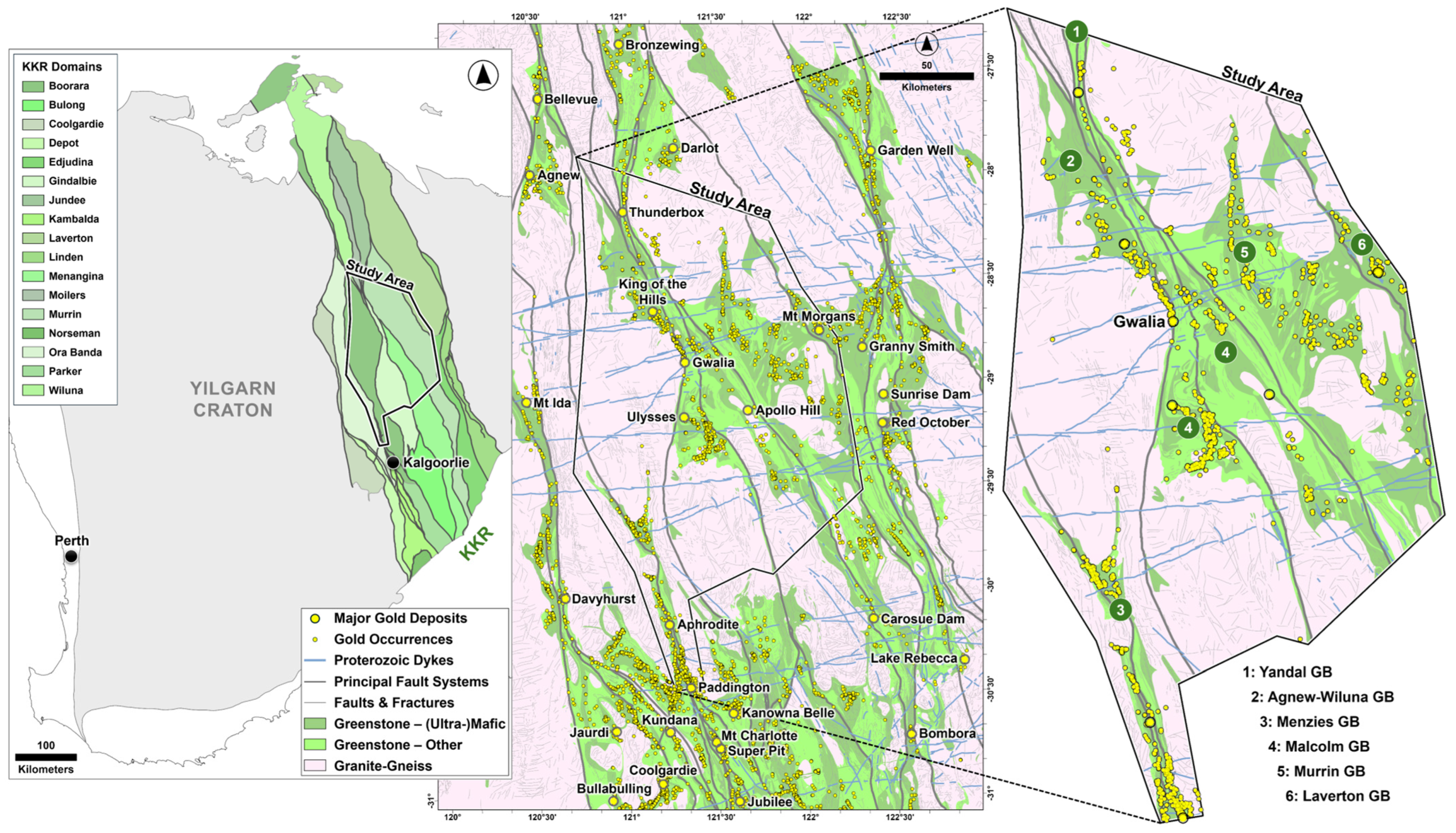


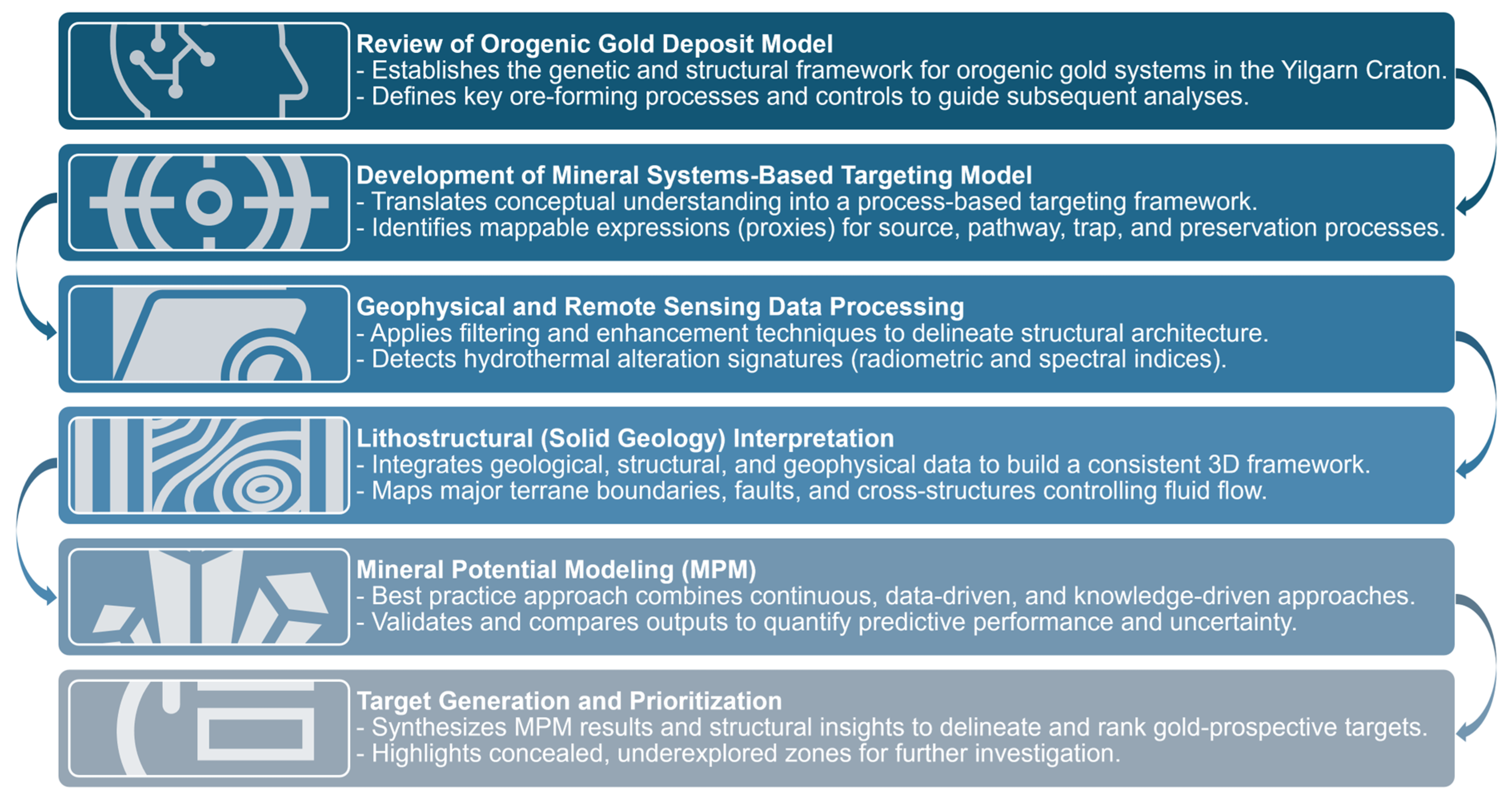
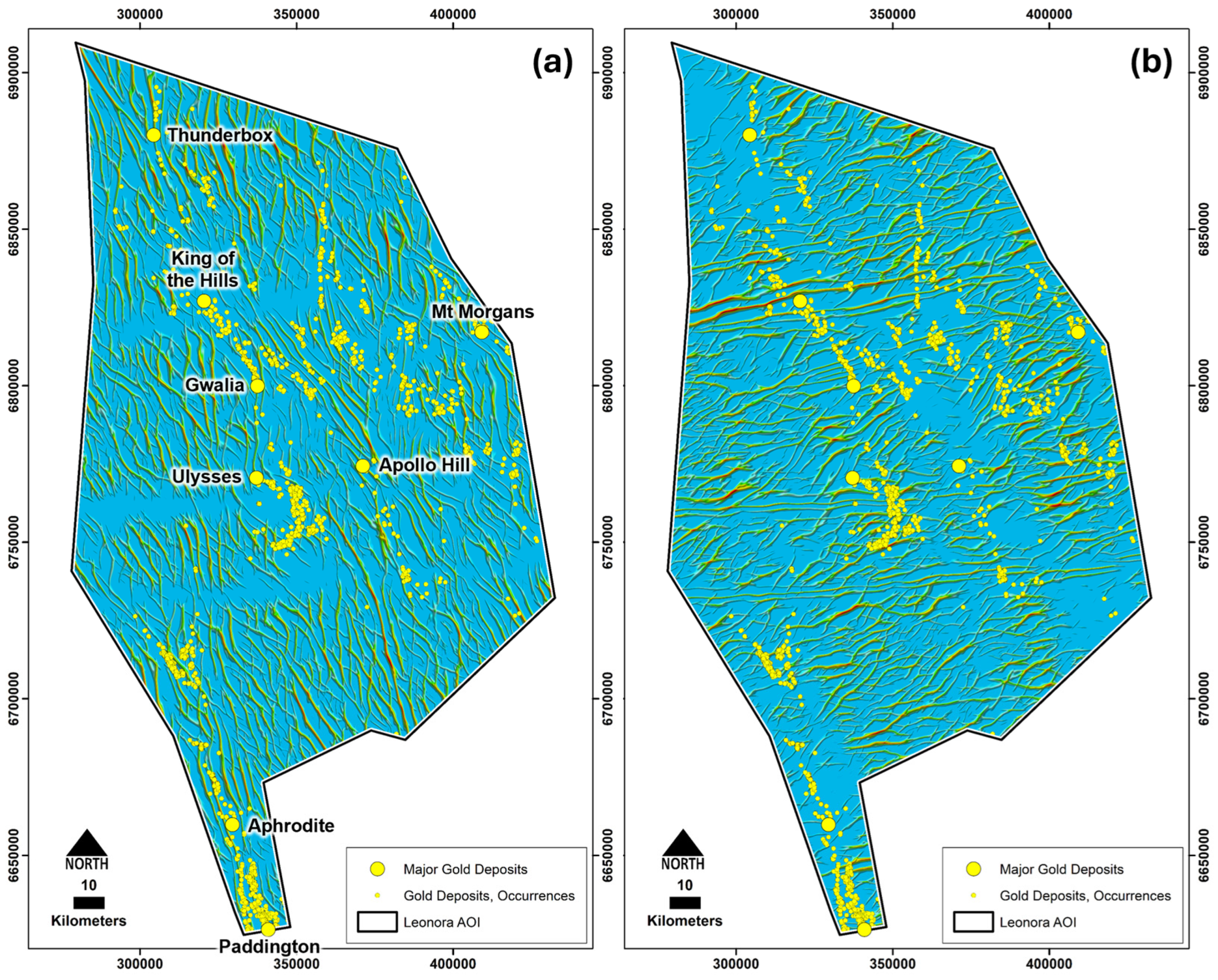
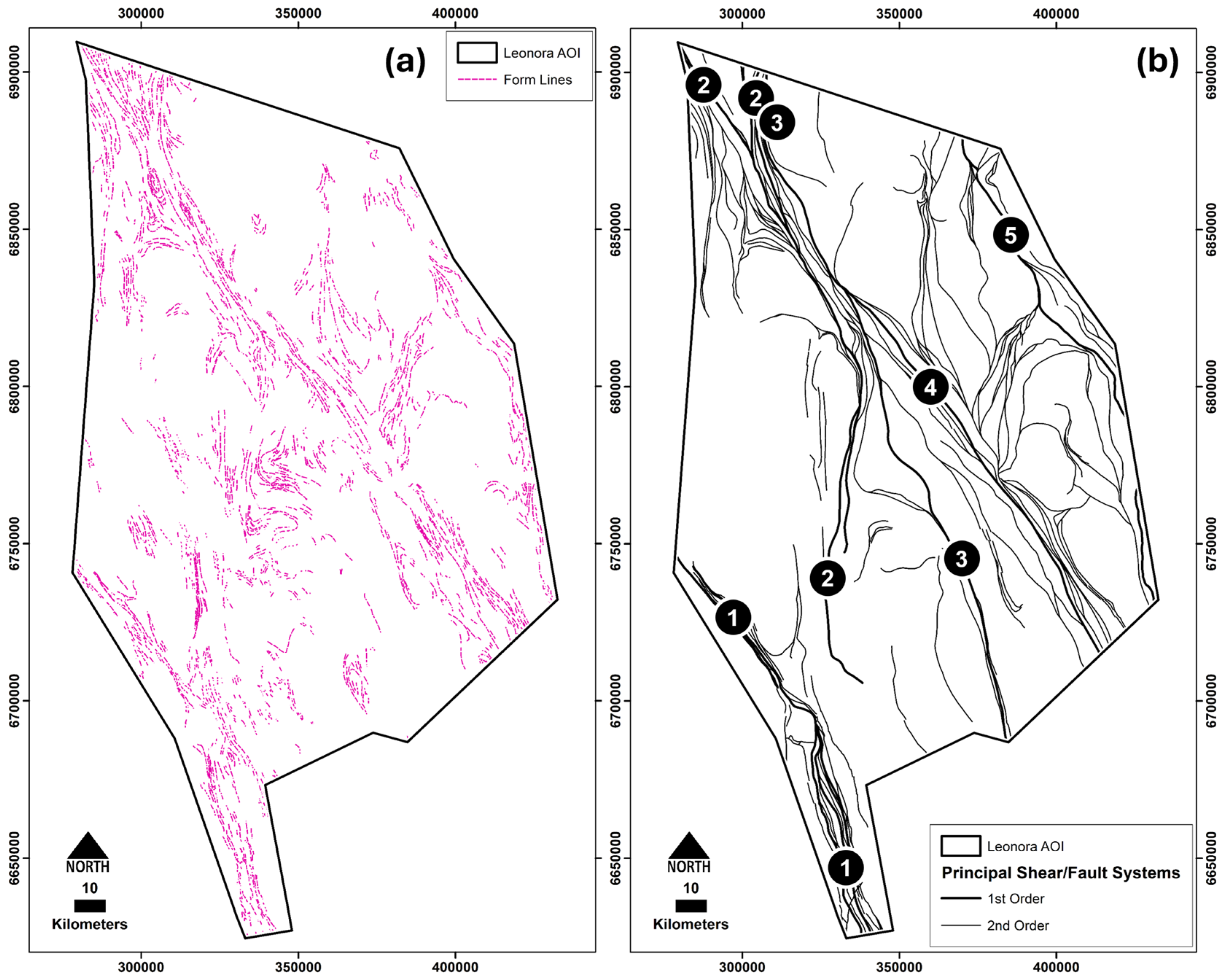
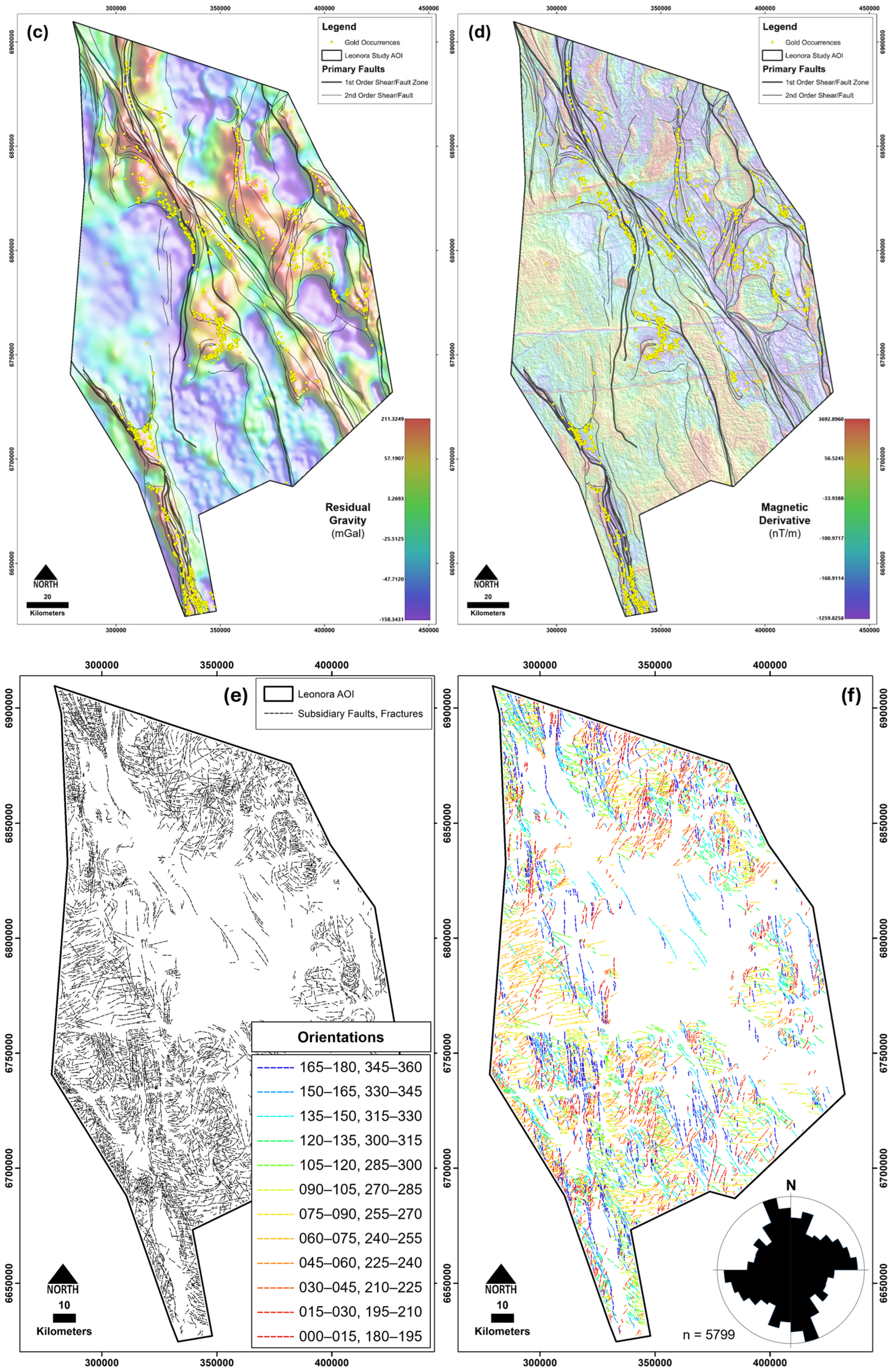
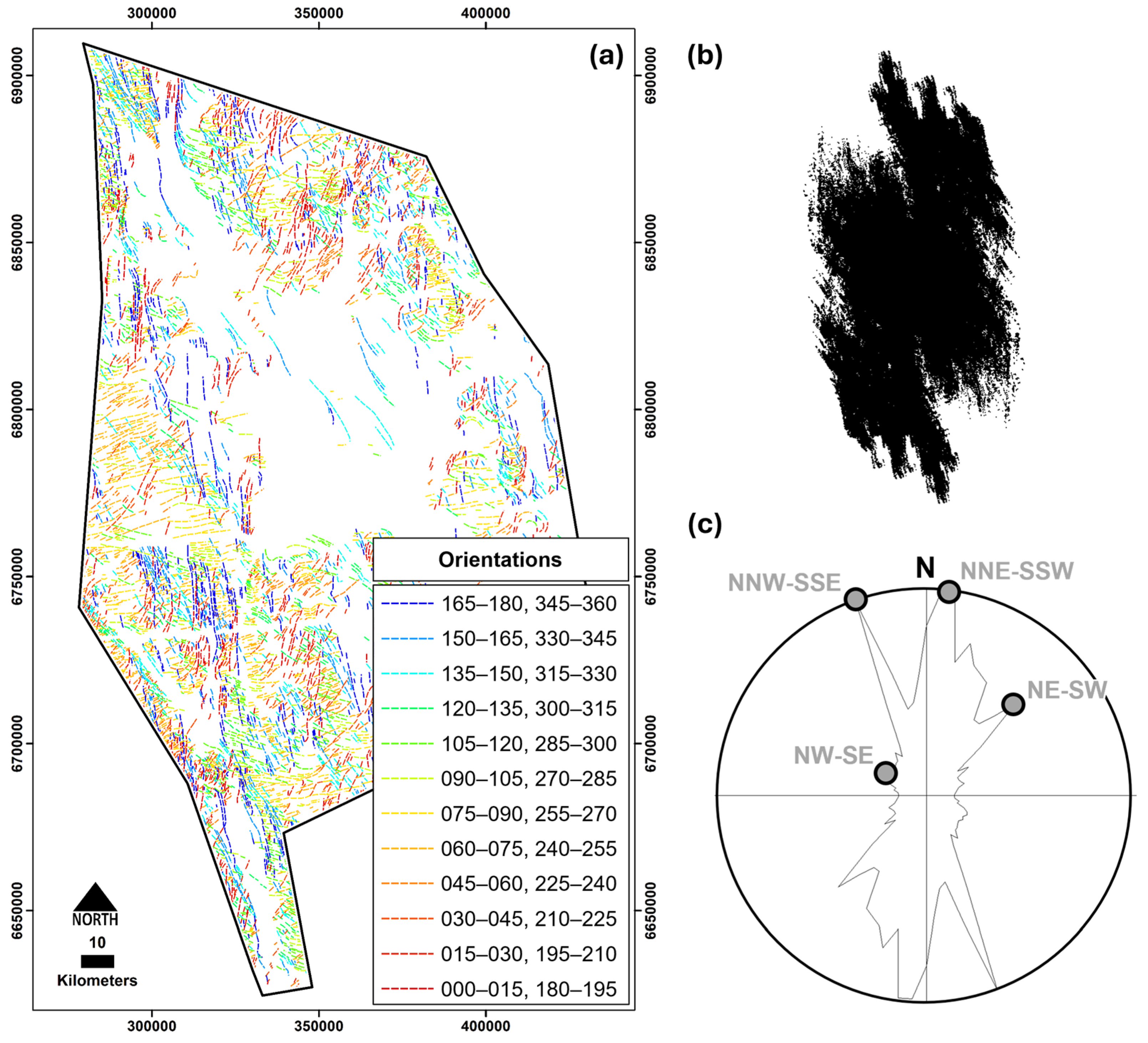
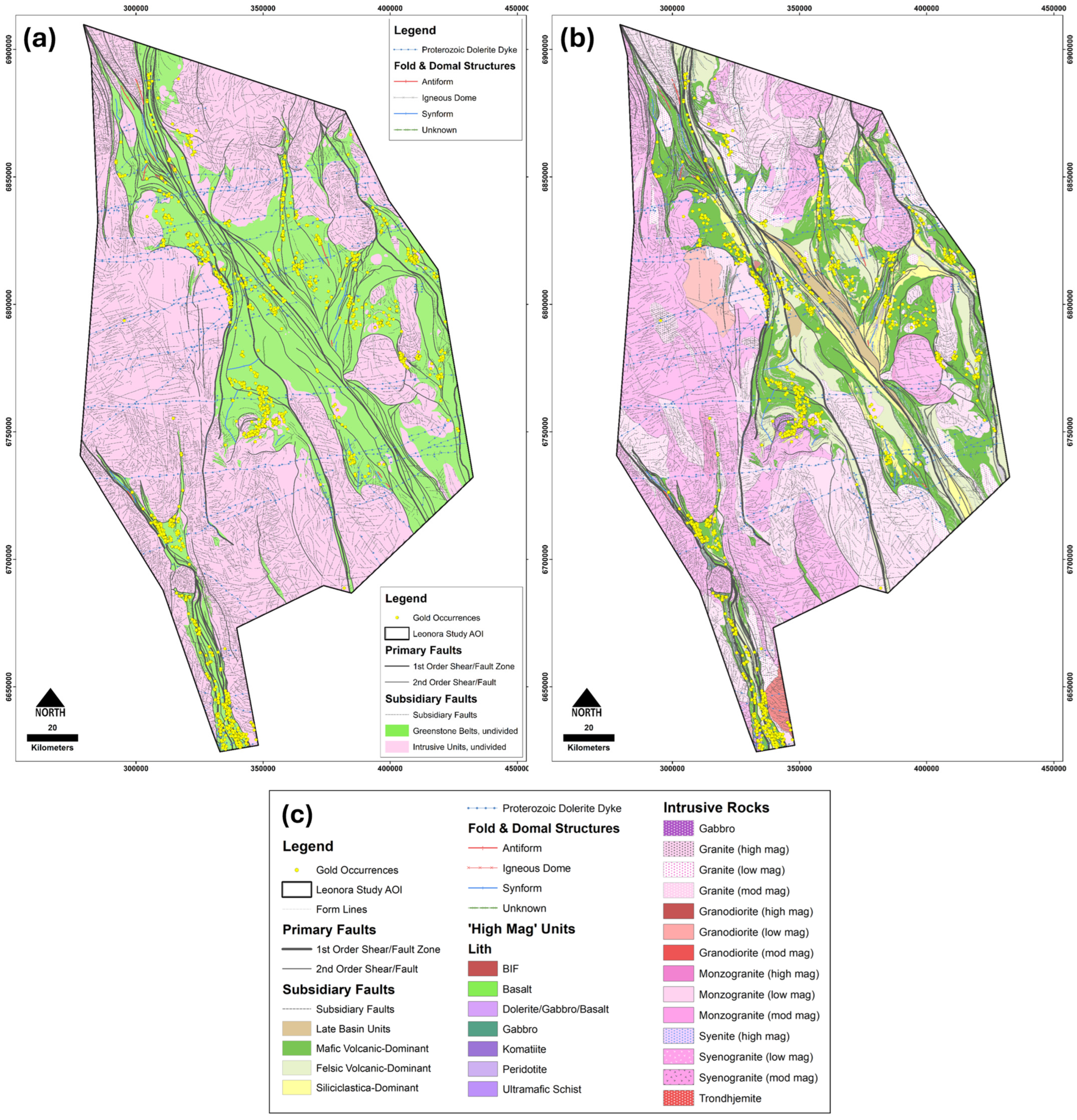


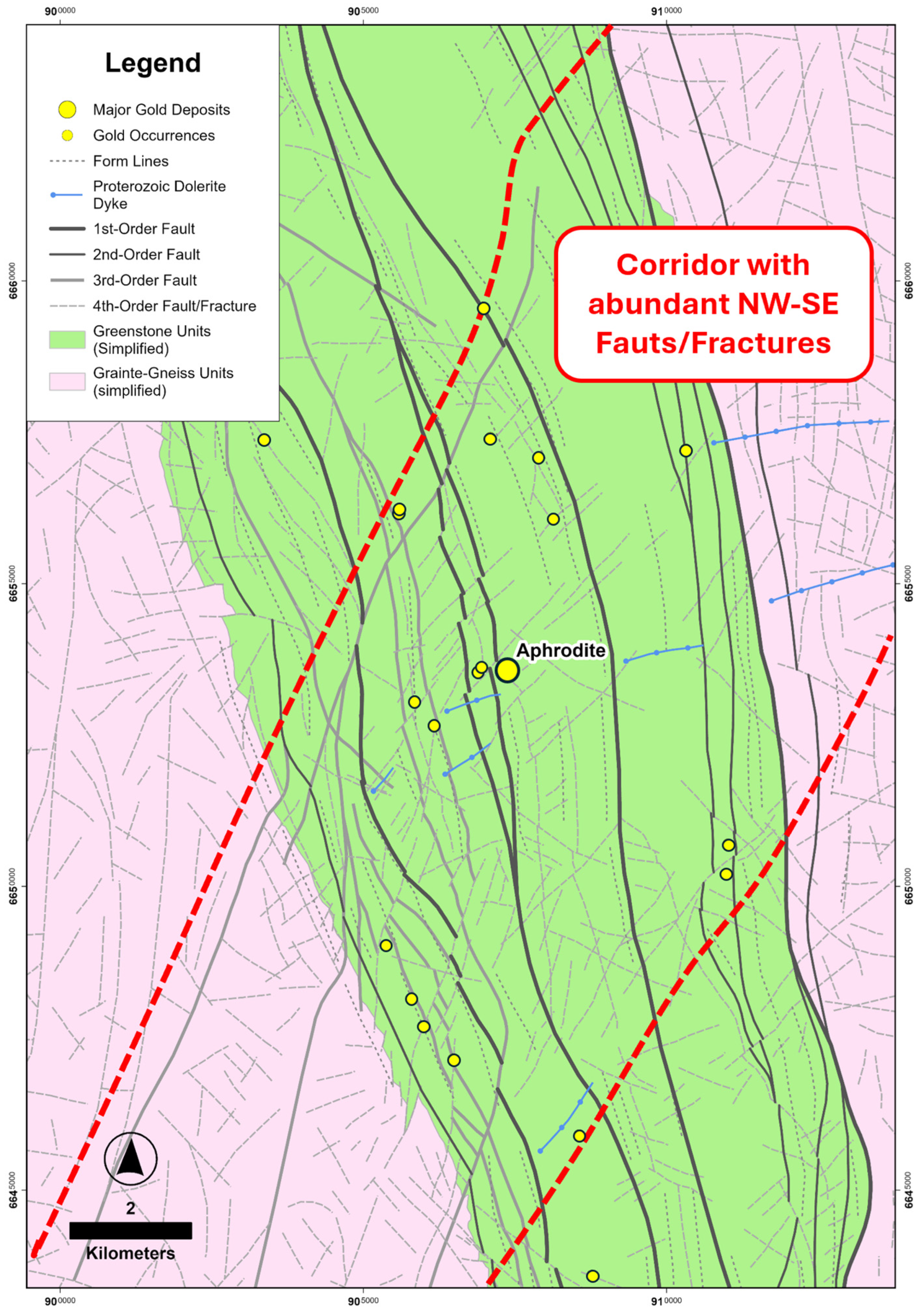
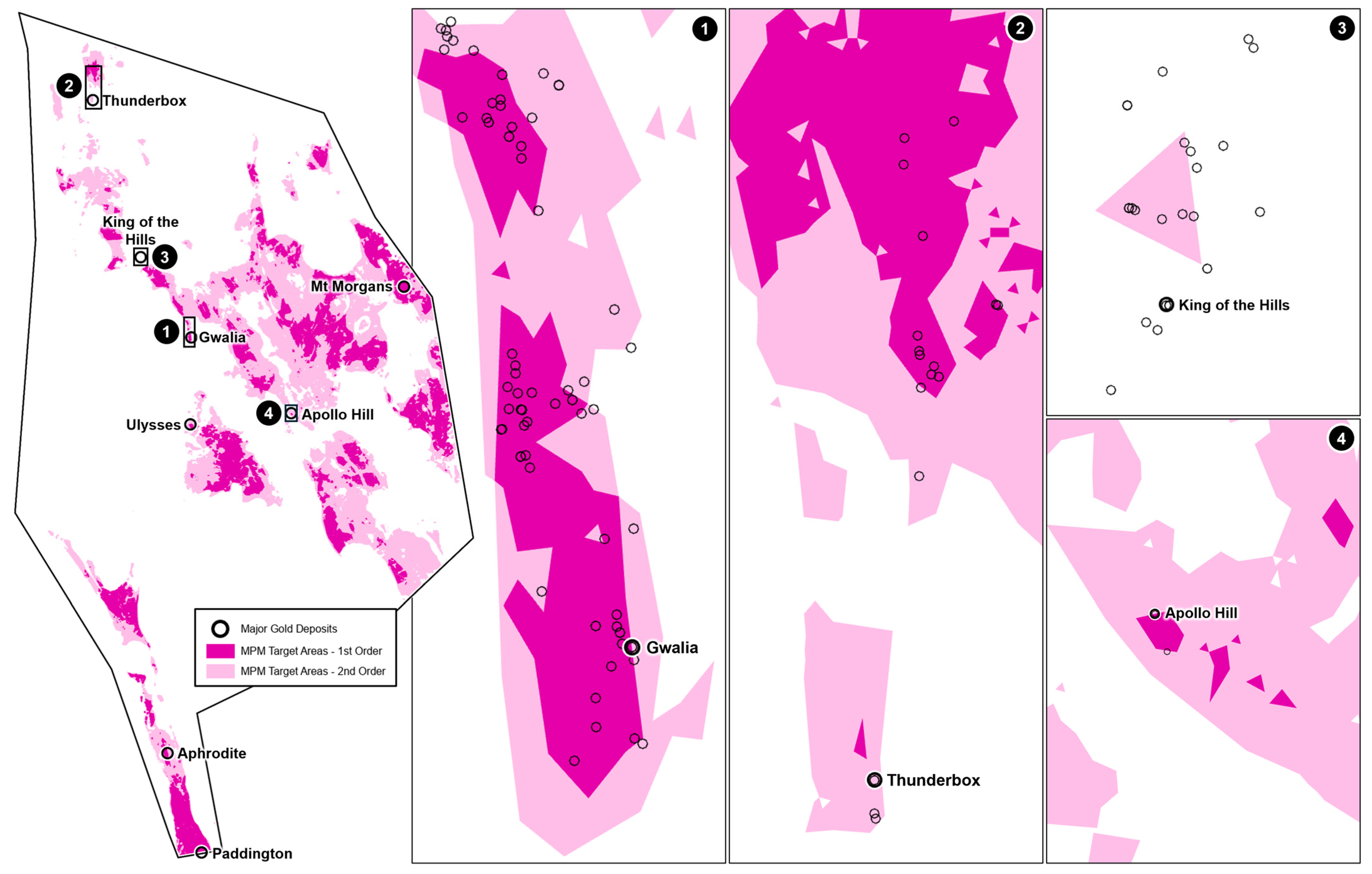
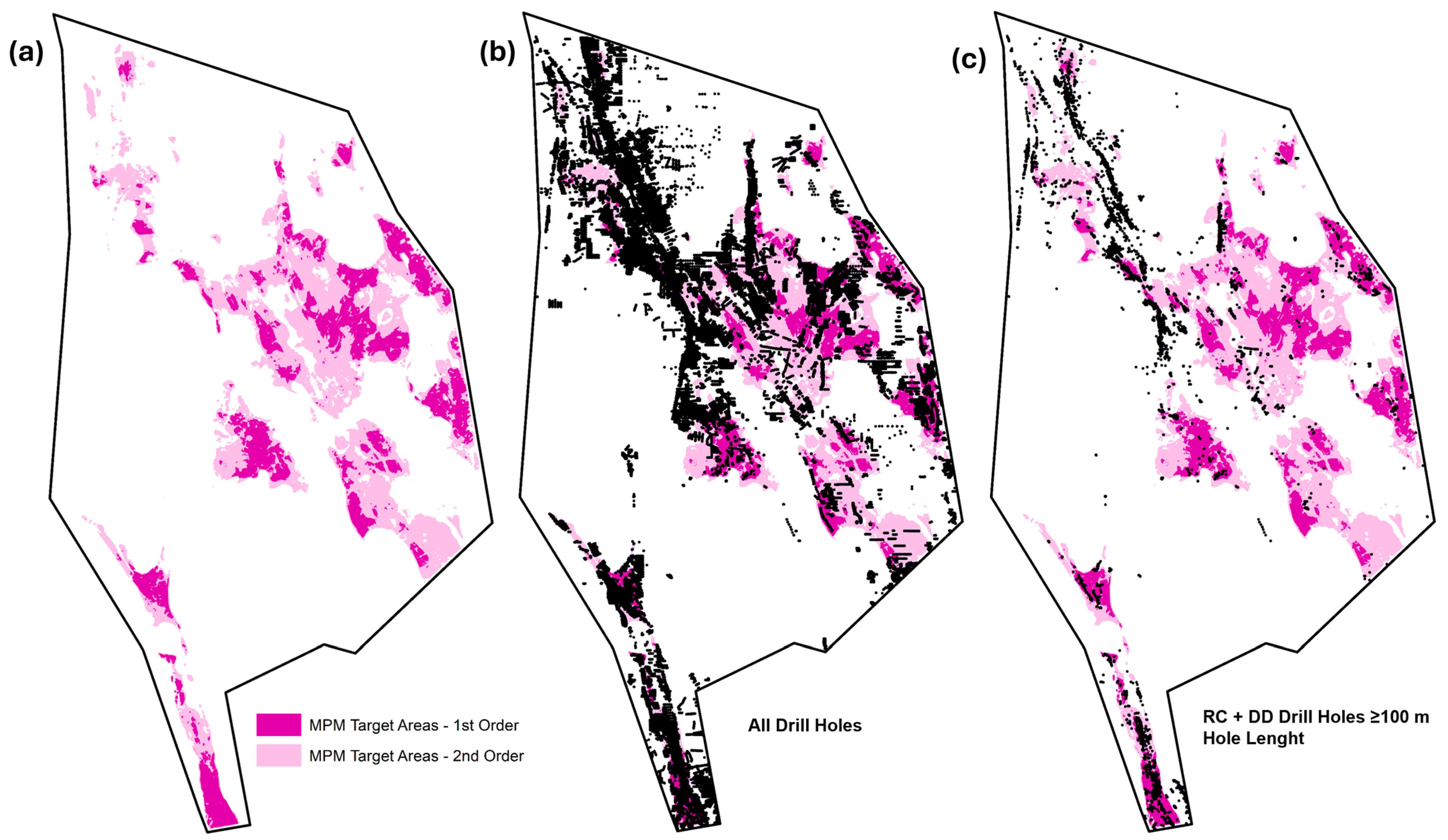

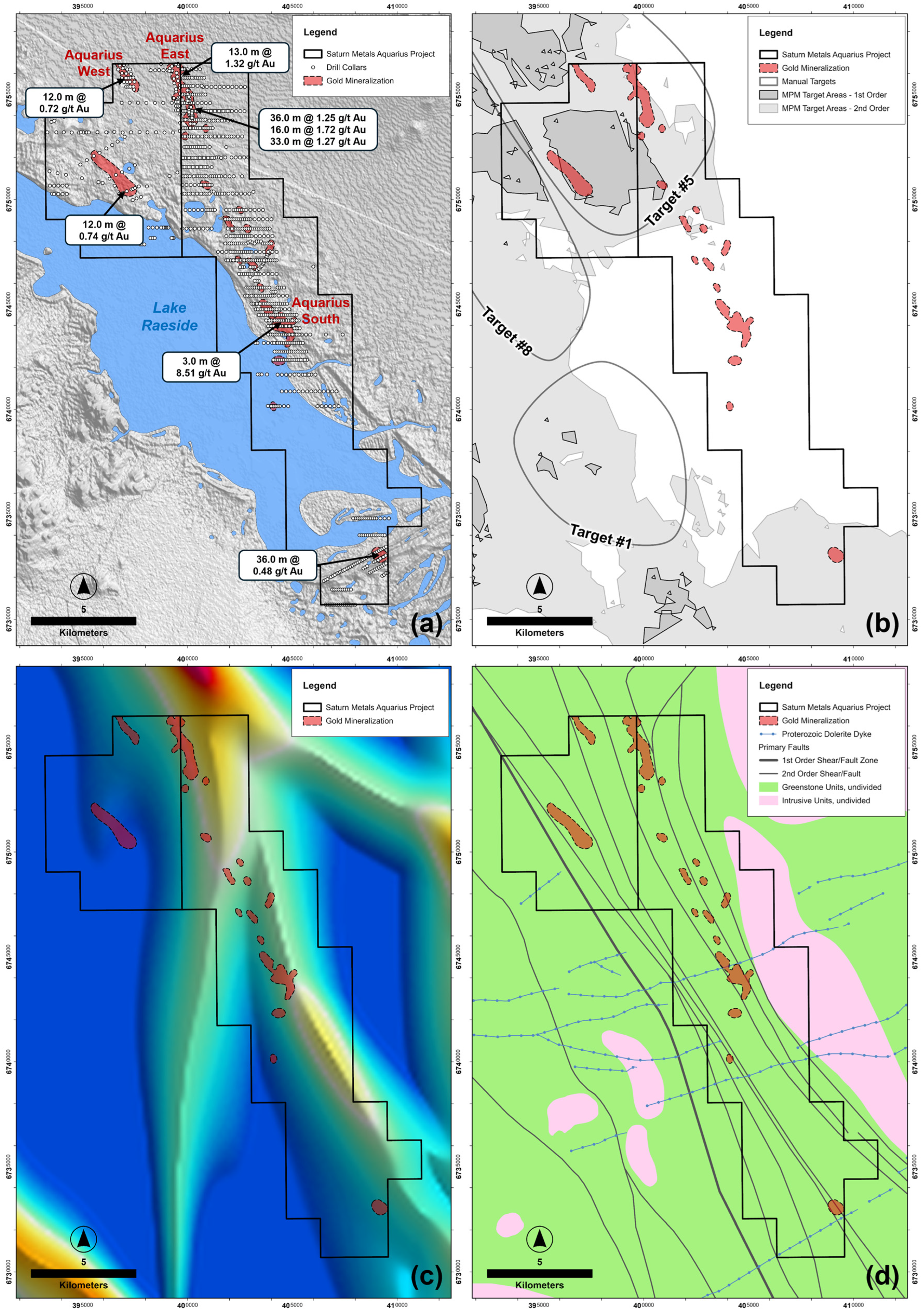

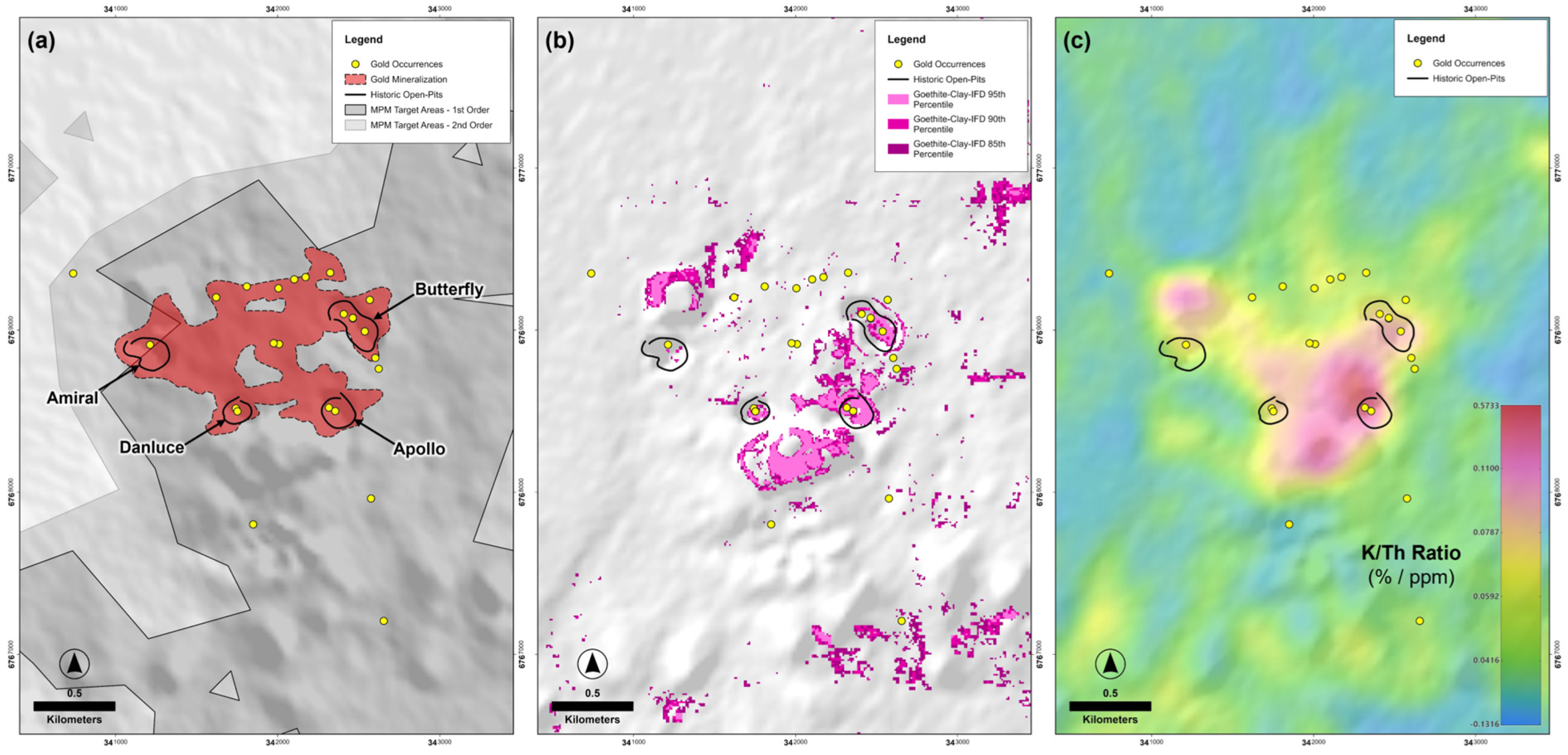
| Deposit Name | Discovery (Year) | Endowment (Moz Au) | Absolute Age (Ma) | Geology and Mineralization |
|---|---|---|---|---|
| Paddington | 1894 | >11.7 | Unk | Principal host rock(s): granophyric qtz-dolerite (greenschist facies); Mineralization style(s): closely spaced, 1 to 5 cm wide, subhorizontal, sheeted gold and sulfide (apy > py, sp > gn)-bearing qtz-dol-ank-ab veins, and a 3 m wide, steeply dipping, laminated, gold- and sulfide (apy > py, ccp, gn > sp)-bearing qtz-cb vein; Alteration type(s): carbonatization, chloritization, sericitization, silicification, sulfidation (apy, py, po); Metal association: Not reported (Au-As?); Ore control(s): D2 kinematics and associated brittle–ductile structures; interaction of key structural elements (synclinal fold structure, location along the crustal-scale Bardoc Tectonic Zone), strong competency contrast between dolerite and surrounding ultramafic and sedimentary rocks |
| Gwalia | 1896 | >8.2 | 2755 | Principal host rock(s): mafic schist, basalt (± pillowed) (lower amphibolite facies); Mineralization style(s): variably deformed, millimeter- to meter-scale, laminated and typically tightly folded and boudinaged gold- and sulfide (py, po > ccp)-bearing qtz-cb veins; Alteration type(s): carbonatization, biotitization, sericitization, silicification, sulfidation (py); Metal association: Not reported; Ore control(s): D2 kinematics and associated ductile structures, interaction of key structural elements (mylonite zone, fold hinge of a large M-shaped fold, Poker/Gwalia Fault, bulge of the Raeside Batholith, proximity to crustal-scale Keith–Kilkenny fault system) |
| Mt Morgans | 1896 | >5.0 | 2650–2630 | Principal host rock(s): banded iron formation (BIF) (greenschist facies); Mineralization style(s): structurally controlled, disseminated gold–sulfide (py > ccp) in BIF and along the margins of qtz-cb veins; Alteration type(s): silicification, carbonatization, sulfidation (py > po, ccp, sp); Metal association: Not reported; Ore control(s): D4/5 kinematics and brittle(–ductile) structures, interaction of key structural elements (fault intersections, fold hinges developed on overturned anticlinal fold structure, dilational jog, proximity to crustal-scale Celia fault system), chemically reactive rock type (mag replacement by sulfides) |
| Tarmoola/King of the Hills | 1897 | >4.4 | 2650–2630 | Principal host rock(s): trondhjemite, komatiite (greenschist facies); Mineralization style(s): sets of conjugate, 20 cm to 2 m wide, gold-, telluride-, sulfide (py, ccp, sp, gn)- and ±scheelite-bearing, laminated qtz-cb veins and breccias; Alteration type(s): silicification, carbonatization, sericitization, chloritization, albitization, and sulfidation (py, ccp, sp, ga); Metal association: Au-Sb-Mo-W ± Bi; Ore control(s): D4/5 kinematics and associated brittle–ductile structures, interaction of key structural elements (proximity to local shear zones and crustal-scale Keith–Kilkenny fault system), strong competency contrast between trondhjemite and komatiite, fault–valve action; Note: Tarmoola/King of the Hills is the largest known granite-hosted gold deposit in the Yilgarn Craton |
| Thunderbox | 1999 | >4.4 | Unk | Principal host rock(s): porphyritic dacite (upper greenschist facies); Mineralization styles: structurally controlled, disseminated gold–sulfide (apy, po > py, sp, gn) accumulations and mm to cm thick, boudinaged and folded gold- and sulfide (apy)-bearing qtz veins; Alteration styles: carbonatization, silicification, albitization and sulfidation (apy, po); Metal association: Not reported (Au-As?); Ore control(s): D4/5 kinematics and brittle–ductile structures, interaction of key structural elements (local fold axes, Thunderbox shear zone, proximity to crustal-scale Perseverance fault system), strong competency contrast between porphyritic dacite and enclosing sedimentary and mafic volcanic rocks |
| Apollo Hill | 1986 | >2.0 | Unk | Principal host rock(s): basalt (pillowed), dolerite, felsic volcaniclastic rocks; Mineralization style(s): Four sets of mm to cm thick, sheeted and stockwork-type, gold- and sulfide (py > ccp, sp, gn, po)-bearing qtz-cb veins; Alteration type(s): carbonatization, chloritization, sericitization, silicification, pyritization; Metal association: Not reported (Au-Ag-Cu-Pb-Zn?); Ore control(s): D4/5(?) kinematics and associated brittle–ductile structures, interaction of key structural elements (Apollo-Ra shear zone, proximity to crustal-scale Keith–Kilkenny fault system), strong competency contrast, lithological contacts |
| Aphrodite | 1996 | >1.6 | Unk | Principal host rock(s): volcaniclastic rocks, felsic to intermediate (dacitic) porphyries; Mineralization style(s): conjugate, mm to cm scale gold- and sulfide (py > apy)-bearing qtz veins and breccias; Alteration type(s): silicification, carbonatization, sericitization, biotitization and sulfidation (py > apy > gn, ccp, stb); Metal association: Not reported (Au-As-Sb?); Ore control(s): D2 kinematics and associated brittle–ductile structures; interaction of key structural elements (local fold axes and crenulations, location along the crustal-scale Bardoc Tectonic Zone), strong competency contrast, chemically reactive sedimentary rock |
| Ulysses | 1993 | >1.6 | Unk | Principal host rock(s): qtz-dolerite (sills), basalt; Mineralization style(s): stacked, shear zone-hosted, gold- and sulfide-bearing qtz veins; Alteration type(s): silicification, carbonatization, sericitization, albitization, sulfidation (py, po > ccp) ± biotitization, chloritization; Metal association: Not reported; Ore control(s): D4/5(?) kinematics and associated brittle–ductile structures; interaction of key structural elements (fault intersections with dolerite sills), strong competency contrast |
| Menzies | 1891 | >1.4 | Unk | Principal host rock(s): metasedimentary rock, basalt, amphibolite ± porphyritic granodiorite; Mineralization style(s): locally stacked, shear zone-hosted, gold- and sulfide (py > apy)-bearing qtz veins and zones of brecciation; Alteration type(s): biotitization, chloritization, sericitization, silicification, sulfidation (py, po) ± carbonatization; Metal association: Au-As; Ore control(s): D4/5(?) kinematics and associated brittle–ductile structures; interaction of key structural elements (shear fabric, proximity to Menzies shear zone, location along the crustal-scale Bardoc Tectonic Zone) |
| Wonder | 1890s | >0.9 | Unk | Principal host rock(s): syenogranite (Bundarra Batholith) with partially assimilated greenstone rafts (mafic roof pendants); Mineralization style(s): gold- and sulfide (py > ccp, gn)-bearing qtz veins; Alteration type(s): silicification, carbonatization, sericitization, propylitization (hem), sulfidation (py) ± chloritization; Metal association: Not reported; Ore control(s): D4/5(?) kinematics and associated brittle–ductile structures; interaction of key structural elements (local faults, granite margin, proximity to the crustal-scale Keith–Kilkenny fault system), strong competency contrast between granite and mafic greenstone rafts |
| Zoroastrian | 1894 | >0.6 | Unk | Principal host rock(s): granophyric dolerite; Mineralization style(s): steeply dipping and flat-lying, gold- and sulfide (apy, py, po)-bearing qtz stockwork veins; Alteration type(s): silicification, carbonatization, sericitization, chloritization, sulfidation (apy, py, po); Metal association: Not reported; Ore control(s): D4/5(?) kinematics and associated brittle–ductile structures; interaction of key structural elements (narrow synclinal fold structure, constriction zone between two granite domes, location along the crustal-scale Bardoc Tectonic Zone), strong competency contrast between dolerite and surrounding sedimentary, mafic and ultramafic rocks |
| Category | Data Type/Name | Source | Comments |
|---|---|---|---|
| Gold occurrences | Mines and mineral deposits (MINEDEX) | GSWA | Data available from DEMIRS Data and Software Centre: https://dasc.dmirs.wa.gov.au/ |
| MINEDEX operating mines map | |||
| Geology | 1:100,000 state interpreted bedrock geology of Western Australia | ||
| 1:500,000 interpreted bedrock geology of Western Australia | |||
| 1:100,000 geological series maps | |||
| 1:500,000 state regolith geology | |||
| In-house Eastern Yilgarn Craton geology map | SBM | Confidential dataset | |
| pmd*CRC 1:100,000 solid geology map, eastern Yilgarn Craton | [15] | Data or data links provided in quoted references | |
| Yilgarn Craton metamorphic facies map | [11,36] | ||
| Geochemistry | Yilgarn Craton εNd (juvenile crust) map | [34] | |
| Drilling | Mineral exploration drill holes (open file) | GSWA | Confidential dataset |
| Leonora drill hole database | SBM | https://dasc.dmirs.wa.gov.au/ | |
| Geophysics | 400 m Bouguer gravity merged grid of Western Australia 2020 version 1 | GSWA | Data available from MAGIX Online: https://geodownloads.dmp.wa.gov.au/downloads/geophysics/72203/, https://geodownloads.dmp.wa.gov.au/downloads/geophysics/72204/ and https://geodownloads.dmp.wa.gov.au/downloads/geophysics/72205/ |
| 40 m reduced to the pole (RTP) magnetic merged grid of Western Australia 2021 version 1 | |||
| Radiometric grids (80 m) of Western Australia | |||
| Remote Sensing | ALOS World 3D—30 m (AW3D30) ALOS Global Digital Surface Model | OpenTopography | Data available from https://opentopography.org/ |
| Sentinel-2 (blue, green, red, and near-infrared (NIR) bands at 10 m and other bands at 20 m resolution) | European Space Agency | Data available from https://dataspace.copernicus.eu |
| Critical Processes | Constituent Processes | Targeting Criteria (Proxies) | Rationale for Proxies | Proxies Used for MPM |
| Source | Availability of energy to drive and sustain the mineral system | Source processes related to orogenic Au systems are cryptic in nature:
| Broad consensus exists in terms of orogenic Au systems of the Yilgarn Craton being formed in convergent margin settings, particularly in accretionary orogens, which, if mineralized, involve the following ingredients [34,116,117]:
| Proximity to the following:
|
| Availability of fertile Au source region | ||||
| Availability of melts and fluids to extract Au from source region | ||||
| Availability of ligands to enhance Au solubility | ||||
| Favorable geodynamic/tectonic (“ground-preparation”) history | ||||
| Transport | Fundamental translithospheric structures | First-order fault systems |
| Proximity to the following:
|
| Crustal structures | Second-order fault systems |
| ||
| Regional folds |
| |||
| Domes |
| |||
| Greenstone constriction zones |
| |||
| Late basins |
| |||
| Proterozoic dolerite dyke swarms |
| |||
| Trap | Transient catastrophic rock failure and concomitant structurally controlled, and highly focused fluid flow | Second- and higher-order faults |
| |
Fault irregularities
|
| |||
| Structural intersections and intersection density |
| |||
| Fold structures |
| |||
Ductile structures
|
| |||
| Competency contrasts |
| |||
| Lithological complexity |
| |||
| Deposition | Physicochemical destabilization of Au-bearing fluids | Phase separation |
| |
| Fluid–rock interaction |
| |||
| Fluid mixing |
| |||
| Preservation | Geodynamics | Tectonic setting, crustal depth, and timing of Au deposit formation and post-Au deformation history |
| Not used in this study:
|
| Peneplanation and climate | Peneplained, tectonically stable cratonic environments in (semi-) arid climate zones |
|
| Predictor Map | Pr (%) | Oa (%) | Nd | AUC |
|---|---|---|---|---|
| Proximity to known gold occurrences | 100 | 0 | Infinity | 1.000 |
| Proximity to greenstone belts | 69 | 31 | 2.230 | 0.965 |
| Proximity to domains of favorable metamorphic grade | 69 | 31 | 2.230 | 0.950 |
| Proximity to felsic to intermediate volcanic rocks | 59 | 41 | 1.440 | 0.948 |
| Proximity to regional gravity highs | 71 | 29 | 2.450 | 0.931 |
| Proximity to mafic–ultramafic volcanic rocks | 69 | 31 | 2.230 | 0.922 |
| Proximity to basement granitoids | 71 | 29 | 2.450 | 0.858 |
| Proximity to ‘high mag units’ | 66 | 34 | 1.940 | 0.852 |
| Proximity to areas of demagnetization | 62 | 38 | 1.630 | 0.851 |
| Proximity to subsidiary faults | 66 | 34 | 1.940 | 0.833 |
| Proximity to remotely sensed alteration systems | 72 | 28 | 2.570 | 0.824 |
| Proximity to lithological contacts | 68 | 32 | 2.120 | 0.800 |
| Proximity to fold hinges | 59 | 41 | 1.440 | 0.794 |
| Proximity to internal granitoids | 64 | 36 | 1.770 | 0.788 |
| Density of principal faults | 61 | 39 | 1.560 | 0.786 |
| Proximity to principal faults | 64 | 36 | 1.770 | 0.778 |
| Density of lithological contacts | 58 | 42 | 1.380 | 0.758 |
| Density of ENE-WSW-striking gravity ridges | 63 | 37 | 1.700 | 0.746 |
| Density of NNW-SSE-striking gravity ridges | 59 | 41 | 1.440 | 0.715 |
| Density of principal fault intersections | 59 | 41 | 1.440 | 0.700 |
| Proximity to siliciclastic and sedimentary rocks | 64 | 36 | 1.770 | 0.691 |
| Density of ENE-WSW-striking gravity lineaments | 59 | 41 | 1.440 | 0.669 |
| Proximity to flanks of granitoid bodies | 59 | 41 | 1.440 | 0.639 |
| Density of NNW-SSE-striking gravity lineaments | 56 | 44 | 1.270 | 0.611 |
| Proximity to domains of juvenile crust (εNd-values of −0.2 to 2.4) | 52 | 48 | 1.080 | 0.611 |
| Proximity to domains of high K/Th values (≥95th percentile) | 55 | 45 | 1.220 | 0.560 |
| Proximity to Proterozoic dolerite dykes | 52 | 48 | 1.080 | 0.537 |
| Density of Proterozoic dolerite dykes | 51 | 49 | 1.040 | 0.515 |
| Predictor Map | Entropy (e) | Normalized Entropy Value (h) | Weight (W) |
|---|---|---|---|
| Density of lithological contacts | 6095 | 0.0106 | 0.9894 |
| Proximity to basement granitoids | 7645 | 0.0133 | 0.9867 |
| Proximity to felsic to intermediate volcanic rocks | 8618 | 0.0150 | 0.9850 |
| Density of principal fault intersections | 14,307 | 0.0249 | 0.9750 |
| Density of Proterozoic dolerite dykes | 15,560 | 0.0271 | 0.9729 |
| Density of principal faults | 15,964 | 0.0278 | 0.9722 |
| Proximity to greenstone belts | 16,756 | 0.0292 | 0.9708 |
| Proximity to domains of favorable metamorphic grade | 17,192 | 0.0300 | 0.9700 |
| Proximity to regional gravity highs | 17,325 | 0.0302 | 0.9698 |
| Density of NNW-SSE-striking gravity lineaments | 18,651 | 0.0325 | 0.9675 |
| Density of ENE-WSW-striking gravity ridges | 20,723 | 0.0361 | 0.9639 |
| Density of ENE-WSW-striking gravity lineaments | 20,805 | 0.0363 | 0.9637 |
| Density of NNW-SSE-striking gravity ridges | 21,253 | 0.0371 | 0.9629 |
| Proximity to mafic–ultramafic volcanic rocks | 21,418 | 0.0373 | 0.9627 |
| Proximity to fold hinges | 23,135 | 0.0403 | 0.9597 |
| Proximity to siliciclastic and sedimentary rocks | 23,344 | 0.0407 | 0.9593 |
| Proximity to domains of high K/Th values (≥95th percentile) | 23,608 | 0.0412 | 0.9588 |
| Proximity to domains of juvenile crust (εNd-values of −0.2 to 2.4) | 23,831 | 0.0415 | 0.9585 |
| Proximity to internal granitoids | 24,255 | 0.0423 | 0.9577 |
| Proximity to lithological contacts | 24,480 | 0.0427 | 0.9573 |
| Proximity to remotely sensed alteration systems | 25,084 | 0.0437 | 0.9563 |
| Proximity to ‘high mag units’ | 25,400 | 0.0443 | 0.9557 |
| Proximity to known gold occurrences | 25,649 | 0.0447 | 0.9553 |
| Proximity to flanks of granitoid bodies | 25,836 | 0.0450 | 0.9550 |
| Proximity to areas of demagnetization | 25,900 | 0.0452 | 0.9548 |
| Proximity to Proterozoic dolerite dykes | 26,630 | 0.0464 | 0.9536 |
| Proximity to subsidiary faults | 26,876 | 0.0469 | 0.9531 |
| Proximity to principal faults | 27,249 | 0.0475 | 0.9525 |
| Effective Predictor Maps | Parameters | ||||||
|---|---|---|---|---|---|---|---|
| Pm | Pn | 100 − Pm | 100 − Pn | TPr | FPr | Op | |
| 0to known gold occurrences (DC1) | 100 | 46 | 0 | 54 | 1 | 0.46 | 0.54 |
| Proximity to regional gravity highs (DC2) | 71 | 43 | 29 | 57 | 0.71 | 0.43 | 0.28 |
| Proximity to basement granitoids (DC3) | 71 | 43 | 29 | 57 | 0.71 | 0.43 | 0.28 |
| Proximity to greenstone belts (DC4) | 69 | 42 | 31 | 58 | 0.69 | 0.42 | 0.27 |
| Proximity to domains of favorable metamorphic grade (DC5) | 69 | 43 | 31 | 57 | 0.69 | 0.43 | 0.26 |
| Proximity to mafic–ultramafic volcanic rocks (DC6) | 69 | 44 | 31 | 56 | 0.69 | 0.44 | 0.25 |
| Proximity to subsidiary faults (DC7) | 66 | 42 | 34 | 58 | 0.66 | 0.42 | 0.24 |
| Proximity to remotely sensed alteration systems (DC8) | 72 | 48 | 28 | 52 | 0.72 | 0.48 | 0.24 |
| Proximity to ‘high mag units’ (DC9) | 66 | 43 | 34 | 57 | 0.66 | 0.43 | 0.23 |
| Proximity to principal faults (DC10) | 64 | 43 | 36 | 57 | 0.64 | 0.43 | 0.21 |
| Proximity to lithological contacts (DC11) | 68 | 47 | 32 | 53 | 0.68 | 0.47 | 0.21 |
| Density of ENE-WSW-striking gravity ridges (DC12) | 63 | 45 | 37 | 55 | 0.63 | 0.45 | 0.18 |
| Proximity to internal granitoids (DC13) | 64 | 47 | 36 | 53 | 0.64 | 0.47 | 0.17 |
| Density of principal faults (DC14) | 61 | 45 | 39 | 55 | 0.61 | 0.45 | 0.16 |
| Proximity to siliciclastic and sedimentary rocks (DC15) | 64 | 48 | 36 | 52 | 0.64 | 0.48 | 0.16 |
| Proximity to areas of demagnetization (DC16) | 62 | 46 | 38 | 54 | 0.62 | 0.46 | 0.16 |
| Proximity to fold hinges (DC17) | 59 | 47 | 41 | 53 | 0.59 | 0.47 | 0.12 |
| Proximity to felsic to intermediate volcanic rocks (DC18) | 59 | 48 | 41 | 52 | 0.59 | 0.48 | 0.11 |
| Density of NNW-SSE-striking gravity ridges (DC19) | 59 | 48 | 41 | 52 | 0.59 | 0.48 | 0.11 |
| Density of ENE-WSW-striking gravity lineaments (DC20) | 59 | 48 | 41 | 52 | 0.59 | 0.48 | 0.11 |
| Density of principal fault intersections (DC21) | 59 | 48 | 41 | 52 | 0.59 | 0.48 | 0.11 |
| Proximity to flanks of granitoid bodies (DC22) | 59 | 48 | 41 | 52 | 0.59 | 0.48 | 0.11 |
| Density of lithological contacts (DC23) | 58 | 49 | 42 | 51 | 0.58 | 0.49 | 0.09 |
| Density of NNW-SSE-striking gravity lineaments (DC24) | 56 | 49 | 44 | 51 | 0.56 | 0.49 | 0.07 |
| Proximity to domains of juvenile crust (DC25) | 52 | 47 | 48 | 53 | 0.52 | 0.47 | 0.05 |
| Proximity to domains of high K/Th values (DC26) | 55 | 50 | 45 | 50 | 0.55 | 0.5 | 0.05 |
| Proximity to Proterozoic dolerite dykes (DC27) | 52 | 50 | 48 | 50 | 0.52 | 0.5 | 0.02 |
| Density of Proterozoic dolerite dykes (DC28) | 51 | 51 | 49 | 49 | 0.51 | 0.51 | 0.00 |
| Fuzzy Gamma | Geometric Average | Improved Index Overlay | BWM-SAW | RF | |
|---|---|---|---|---|---|
| Pm (Hits) | 77 | 78 | 79 | 88 | 88 |
| Pn (False Alarms) | 42 | 43 | 42 | 41 | 36 |
| 100−Pm (Misses) | 23 | 22 | 21 | 12 | 12 |
| 100−Pn (Correct Rejection) | 58 | 57 | 58 | 59 | 64 |
| True Positive Rate (TPr) | 0.77 | 0.78 | 0.79 | 0.88 | 0.88 |
| False Positive Rate (FPr) | 0.42 | 0.43 | 0.42 | 0.41 | 0.36 |
| Overall Performance (Op) | 0.35 | 0.35 | 0.37 | 0.47 | 0.52 |
| Parameters | GSWA Database | SBM Database | Comments |
|---|---|---|---|
| Number of drill holes | 231,760 | 77,675 | |
| Main hole type | |||
| RC | 84,078 (36%) | 19,874 (26%) | Only 39% of all drill holes completed in the study area are RC or DD holes, whereas 56% represent geochemical drill holes comprising RAB, AC, and AUG holes. |
| RAB | 62,377 (27%) | 43,180 (56%) | |
| AC | 52,905 (23%) | 8875 (11%) | |
| AUG | 14,276 (6%) | 889 (1%) | |
| DD | 7043 (3%) | 1827 (2%) | |
| Other | 11,081 (5%) | 3030 (4%) | |
| Hole depth—all drill holes | |||
| Min | 0.0 m | 0.0 m | The median value demonstrates that 50% of all drill holes completed in the study area have hole lengths of only 39 m or less. |
| Max | 2895.6 m | 2895.6 m | |
| Median | 39.0 m | 36.0 m | |
| Mean | 50.5 m | 53.9 m | |
| Hole depth—RC holes | |||
| Min | 0.0 m | 0.0 m | Of the 80,078 RC holes in the GSWA database, 31,713 (~40%) targeted Au whilst 32,666 (~41%) targeted Ni ± Co; the remaining holes targeted mostly base metals ± Au. |
| Max | 1043.1 m | 624.6 m | |
| Median | 41.0 m | 69.0 m | |
| Mean | 53.1 m | 81.3 m | |
| Hole depth—DD holes | |||
| Min | 0.0 m | 6.0 m | Of the 7043 DD holes in the GSWA database, 3511 (~50%) targeted Au ± Ag, Ni; the remaining holes targeted mostly base metals ± Au. |
| Max | 2895.6 m | 2895.6 m | |
| Median | 211.9 m | 220.0 m | |
| Mean | 292.8 m | 403.0 m |
| Target ID | Name | Rationale | Exploration and Ownership |
|---|---|---|---|
| #1 | Dingo | Lithostructural target comprising a cluster of poorly tested intrusions of the McAuliffe Well Syenite; partially covered by Lake Raeside; hosts Dingo and Bull Terrier Au occurrences; proximal to 1st-order Keith–Kilkenny fault system; located along an NNW-SSE-trending gravity ridge | Shallow saprolite drilling only although open-file drill hole data appear to be incomplete; best historic drill intercept: 1.00 m @ 12.28 g/t Au; disjointed ownership |
| #2 | Westralia North | Lithostructural target comprising BIF units and syenite intrusions; Korong and Akicia Au occurrences; proximal to 1st-order Celia fault system; located along an NNW-SSE gravity ridge; along strike from the Mt Morgans Au deposit | No deep drilling >150 m vertical; best historic drill intercept: 6.70 m @ 13.15 g/t Au; disjointed ownership |
| #3 | Mt Boyce | Lithostructural target; largely soil covered; no reported Au occurrences in 2021; proximal to 1st-order Keith–Kilkenny fault system; located along an NNW-SSE-trending gravity ridge | No deep drilling >100 m vertical; best historic drill intercept: 2.00 m @ 34.50 g/t Au |
| #4 | Mt Redcastle | Lithostructural target in ‘nose region’ of a large granite dome and comprising internal granitoids; hosts several known Au occurrences; proximal to unnamed 2nd-order fault system; located along NW-SE-trending gravity ridge | No deep drilling >100 m; disjointed ownership |
| #5 | Mt Remarkable | Lithostructural target covering part of the Pig Well Basin; no reported Au occurrences in 2021; proximal to 1st-order Keith–Kilkenny fault system; located along an NNW-SSE-trending gravity ridge | Drilling is mostly associated with the Marvellous Au occurrence; best historic drill intercept: 82.00 m @ 0.83 g/t Au; disjointed ownership; partly located within an extensive registered site of Aboriginal cultural heritage |
| #6 | Twenty Six Well | Lithostructural target; largely soil covered; no reported Au occurrences in 2021; proximal to 1st-order Keith–Kilkenny fault system; located along an NNW-SSE-trending gravity ridge | Minimal drilling; disjointed ownership |
| #7 | Malcolm | Lithostructural target comprising BIF units; hosts numerous Au occurrences over a strike length of 10 km; located in between the 1st-order Keith–Kilkenny and Melita-Emu fault systems; located along an NNW-SSE-trending gravity ridge | Limited drilling; best historic drill intercept: 11.00 m @ 1.75 g/t Au + 10.00 m @ 1.26 g/t Au; disjointed ownership |
| #8 | Lake Raeside | Lithostructural target covering part of the Pig Well Basin; largely covered by lake Raeside; proximal to 1st-order Keith–Kilkenny fault system; located along an NNW-SSE-trending gravity ridge | Minimal drilling; disjointed ownership; partly located within an extensive registered site of Aboriginal cultural heritage |
Disclaimer/Publisher’s Note: The statements, opinions and data contained in all publications are solely those of the individual author(s) and contributor(s) and not of MDPI and/or the editor(s). MDPI and/or the editor(s) disclaim responsibility for any injury to people or property resulting from any ideas, methods, instructions or products referred to in the content. |
© 2025 by the authors. Licensee MDPI, Basel, Switzerland. This article is an open access article distributed under the terms and conditions of the Creative Commons Attribution (CC BY) license (https://creativecommons.org/licenses/by/4.0/).
Share and Cite
Kreuzer, O.P.; Roshanravan, B.; Buckingham, A.J.; Core, D.P.; Konecke, B.A.; McDwyer, D.; Mustard, R. Controls, Expressions, and Discovery Potential of Gold Mineralization in the Central-Eastern Yilgarn Craton, Western Australia: New Insights from an Integrated Targeting Study. Minerals 2025, 15, 1255. https://doi.org/10.3390/min15121255
Kreuzer OP, Roshanravan B, Buckingham AJ, Core DP, Konecke BA, McDwyer D, Mustard R. Controls, Expressions, and Discovery Potential of Gold Mineralization in the Central-Eastern Yilgarn Craton, Western Australia: New Insights from an Integrated Targeting Study. Minerals. 2025; 15(12):1255. https://doi.org/10.3390/min15121255
Chicago/Turabian StyleKreuzer, Oliver P., Bijan Roshanravan, Amanda J. Buckingham, Daniel P. Core, Brian A. Konecke, Daniel McDwyer, and Roger Mustard. 2025. "Controls, Expressions, and Discovery Potential of Gold Mineralization in the Central-Eastern Yilgarn Craton, Western Australia: New Insights from an Integrated Targeting Study" Minerals 15, no. 12: 1255. https://doi.org/10.3390/min15121255
APA StyleKreuzer, O. P., Roshanravan, B., Buckingham, A. J., Core, D. P., Konecke, B. A., McDwyer, D., & Mustard, R. (2025). Controls, Expressions, and Discovery Potential of Gold Mineralization in the Central-Eastern Yilgarn Craton, Western Australia: New Insights from an Integrated Targeting Study. Minerals, 15(12), 1255. https://doi.org/10.3390/min15121255











